| | 
No other area of the world suffered so great losses of Jewish life and culture to Nazi led terror as did the countries of Eastern Europe. Over 90% of Poland's three and one half million Jews perished in the Holocaust, in its ghettos, in its killing fields, on its death marches, and in its camps. Today Poland and the Czech Republic seek to find appropriate ways to honor the Jewish dead in an attempt to atone for their own complicity in the perpetration of the largest systematic murder in history that victimized their non-Jewish populations as well.
Below I have documented methods of memorialization at these concentration camps and death camps in Poland and the Czech Republic: Majdanek, Belzec, Auschwitz, Birkenau, and Plaszow in Poland; and the Terezin Gestapo Prison in the Czech Republic. Other places of Holocaust commemorization documented here deal with Ghetto sites and other places of memorialization in Warsaw and Krakow in Poland, the Jewish District of Prague, and the Theresienstadt Ghetto in the Czech Republic.

Jewish Ghettos were established by an order from Reinhard Heydrich on September 21, 1939, three weeks after the beginning of the war. This order made it the responsibility of a Nazi-appointed council of Jewish Elders to force their people into the ghettos. Jews were sent from small towns and villages by train. Transported in locked passenger cars, large numbers died on the journeys.
Jews were separated from the non-Jewish population first by barbed wire, then by walls impregnated with shards of glass. New arrivals were crowded into rooms with other families, and hundreds of thousands of Jews were forced to live in a space of a few city blocks. A Nazi report estimated that there were seven Jews living in every room in the Warsaw ghetto. In the first years, the most prevalent threat to life in the ghettos was starvation. Between 1940 and 1942 an estimated 100,000 Jews died of starvation and disease in the Warsaw Ghetto alone.
The first ghetto was set up in Piotrkow, Poland on 28th October 1939. The two largest ghettos were established in Warsaw and Lodz. Other main ghettos were set up in Krakow, Lublin, and Lvov. The ghettos were a preliminary step in the annihilation of the Jews, rather than just a method to isolate them from the rest of society. As the war against the Jews progressed, the ghettos became transition areas, used as collection points for deportation to death camps and concentration camps.

 The Jewish Historical Institute is located in the building of the former Main Judaic Library, built during the years 1928 - 1936. The building housed library space, reading rooms and large auditorium and exhibition rooms. The structure harmoniously blended with the Great Synagogue adjacent to it, which had been built during the years 1876 - 1878. This pre-war picture of the Library and the Synagogue is on display at the Institute. The Jewish Historical Institute is located in the building of the former Main Judaic Library, built during the years 1928 - 1936. The building housed library space, reading rooms and large auditorium and exhibition rooms. The structure harmoniously blended with the Great Synagogue adjacent to it, which had been built during the years 1876 - 1878. This pre-war picture of the Library and the Synagogue is on display at the Institute.
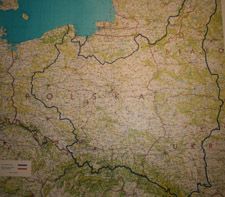 The Jewish Historical Institute was founded with its main goal to save from oblivion both the history of the murder of Polish Jews, and the heritage of their eight centuries old culture and civilization. In 1946, there were 200,000 Jews living in Poland, only 6% of their prewar population of 3.5 million. Several waves of emigration after the war meant that about 95% of those Jews in Poland who had survived the Holocaust left the country. The Institute's role must thus be defined differently today than at the time of its foundation. The Jewish Historical Institute was founded with its main goal to save from oblivion both the history of the murder of Polish Jews, and the heritage of their eight centuries old culture and civilization. In 1946, there were 200,000 Jews living in Poland, only 6% of their prewar population of 3.5 million. Several waves of emigration after the war meant that about 95% of those Jews in Poland who had survived the Holocaust left the country. The Institute's role must thus be defined differently today than at the time of its foundation.
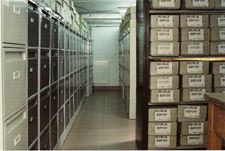 Currently, its mission is three-fold: First, it is a center to preserve documentary materials related to the Jewish historical presence in Poland, while also being a center for academic research, learning, and the dissemination of knowledge about the history of Jews in Poland. Second, it is an important bridge between the Polish-Jewish Diaspora and the land of their ancestors. More than half of the world's Jews today have roots in Poland. The Institute's third mission is linked to Poland's democratization and the spread of democratic values throughout Polish society by helping to reconstruct a true vision of Poland's past as a country in which Jews formed an integral part. The Institute has become a bridge to a historical consciousness in Polish society bringing it closer to a truer picture of Polish history. Director Feliks Tych affirms the "goal is to make the Institute an important and influential place of academic research and a permanent educational center providing information about the history and culture of the Polish Jews." Currently, its mission is three-fold: First, it is a center to preserve documentary materials related to the Jewish historical presence in Poland, while also being a center for academic research, learning, and the dissemination of knowledge about the history of Jews in Poland. Second, it is an important bridge between the Polish-Jewish Diaspora and the land of their ancestors. More than half of the world's Jews today have roots in Poland. The Institute's third mission is linked to Poland's democratization and the spread of democratic values throughout Polish society by helping to reconstruct a true vision of Poland's past as a country in which Jews formed an integral part. The Institute has become a bridge to a historical consciousness in Polish society bringing it closer to a truer picture of Polish history. Director Feliks Tych affirms the "goal is to make the Institute an important and influential place of academic research and a permanent educational center providing information about the history and culture of the Polish Jews."
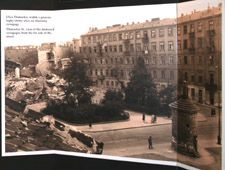 An ironic turn of events in the middle and closing years of WWII fated the Institute into becoming the guardian of the richest collection of objects from Jewish culture that survived the Holocaust. When the residents of the Warsaw Ghetto began to be deported to the extermination center in Treblinka in July 1942, the Germans used the Institute building as a warehouse for looted items. After the squelching of the Warsaw Uprising on May 16, 1943, the Great Synagogue was destroyed by the Germans in retaliation, and the Institute was heavily damaged. (Site of the destroyed synagogue pictured above). In 1946, the Warsaw government gave the sites over to the Central Committee of Jews in Poland. The Committee, in conjunction with the Central Jewish Historical Commission, began hunting for and preserving material traces of Jewish past in the wreckage, while also collecting evidence of Nazi war crimes. All the materials collected were then stored in the renovated Jewish Historical Institute building. An ironic turn of events in the middle and closing years of WWII fated the Institute into becoming the guardian of the richest collection of objects from Jewish culture that survived the Holocaust. When the residents of the Warsaw Ghetto began to be deported to the extermination center in Treblinka in July 1942, the Germans used the Institute building as a warehouse for looted items. After the squelching of the Warsaw Uprising on May 16, 1943, the Great Synagogue was destroyed by the Germans in retaliation, and the Institute was heavily damaged. (Site of the destroyed synagogue pictured above). In 1946, the Warsaw government gave the sites over to the Central Committee of Jews in Poland. The Committee, in conjunction with the Central Jewish Historical Commission, began hunting for and preserving material traces of Jewish past in the wreckage, while also collecting evidence of Nazi war crimes. All the materials collected were then stored in the renovated Jewish Historical Institute building.
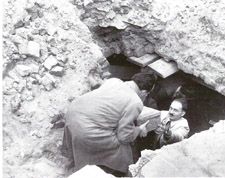 A particularly valuable part of the Institute's collections is the unique clandestine Warsaw Ghetto Archive, known by the name of the man who created it, the Ringelblum Archive. Emmanuel Ringelblum formed and directed a group whose main task was to document what life was like in the Warsaw Ghetto, the largest ghetto in occupied Europe. The secret archive was hidden on August 3, 1942 and then buried beneath the basement of a school in February 1943. Another set of materials was hidden the night before the ghetto uprising. Only the documents hidden beneath the school were recovered after the war. In all, there are an estimated 6,000 documents in the Ringelblum Archive - about 30,000 individual pieces of paper. A particularly valuable part of the Institute's collections is the unique clandestine Warsaw Ghetto Archive, known by the name of the man who created it, the Ringelblum Archive. Emmanuel Ringelblum formed and directed a group whose main task was to document what life was like in the Warsaw Ghetto, the largest ghetto in occupied Europe. The secret archive was hidden on August 3, 1942 and then buried beneath the basement of a school in February 1943. Another set of materials was hidden the night before the ghetto uprising. Only the documents hidden beneath the school were recovered after the war. In all, there are an estimated 6,000 documents in the Ringelblum Archive - about 30,000 individual pieces of paper.
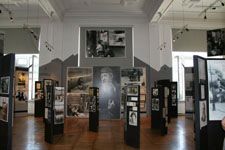 The Institute's exhibit rooms on the second floor are dedicated to The Life, Struggle, and Destruction of the Warsaw Ghetto 1940-1943. The exhibition shows the Holocaust's successive stages in Warsaw, from the first anti-Jewish decrees of the German authorities, to the sealing of the ghetto, then the annihilation of nearly all its residents. The exhibition is for the most part based on materials from the Ringelblum Archive. Most of the display materials are photographs and documents - there are very few three-dimensional artifacts from the ghetto since most everything in the Jewish quarter was destroyed. Click here ---->Exhibit<.---- to view more from the exhibit. The Institute's exhibit rooms on the second floor are dedicated to The Life, Struggle, and Destruction of the Warsaw Ghetto 1940-1943. The exhibition shows the Holocaust's successive stages in Warsaw, from the first anti-Jewish decrees of the German authorities, to the sealing of the ghetto, then the annihilation of nearly all its residents. The exhibition is for the most part based on materials from the Ringelblum Archive. Most of the display materials are photographs and documents - there are very few three-dimensional artifacts from the ghetto since most everything in the Jewish quarter was destroyed. Click here ---->Exhibit<.---- to view more from the exhibit.
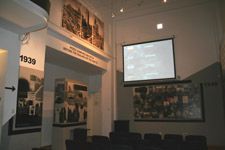 The exhibition includes documentary films that were made especially for the Institute. A 32 minute film about the Warsaw Ghetto is available in seven languages: Polish, English, Hebrew, German, French, Spanish, and Russian. It should be mentioned, that all the information placards on the exhibits are in both Polish and English, showing that they have directed their exhibit towards an international audience. The exhibition includes documentary films that were made especially for the Institute. A 32 minute film about the Warsaw Ghetto is available in seven languages: Polish, English, Hebrew, German, French, Spanish, and Russian. It should be mentioned, that all the information placards on the exhibits are in both Polish and English, showing that they have directed their exhibit towards an international audience.
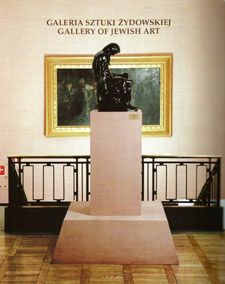 In the permanent art exhibition on the third floor, works of both Ashkenazi and Sephardic art are represented. The latter are items from Greek Jews who perished in the camps of Auschwitz and Majdanek. After the war, items were found in warehouses that had been used by the Germans. These include silver containers, candlesticks, lamps, and wine goblets. In the main exhibition room are paintings and sculptures, including pieces by some of the most important Jewish artists of the 19th century. This extraordinary exhibit of Jewish art and culture reflects the shared intent of other venues who believe that visitors can only appreciate the catastrophe of the Holocaust when they see and experience the extent of the culture lost. In the permanent art exhibition on the third floor, works of both Ashkenazi and Sephardic art are represented. The latter are items from Greek Jews who perished in the camps of Auschwitz and Majdanek. After the war, items were found in warehouses that had been used by the Germans. These include silver containers, candlesticks, lamps, and wine goblets. In the main exhibition room are paintings and sculptures, including pieces by some of the most important Jewish artists of the 19th century. This extraordinary exhibit of Jewish art and culture reflects the shared intent of other venues who believe that visitors can only appreciate the catastrophe of the Holocaust when they see and experience the extent of the culture lost.
Return to top of page

 Upon our arrival in Warsaw, I was pleasantly surprised to see a beautiful, bustling rebuilt city, which bore little to no resemblance to the pictures of total destruction immediately following WWII. During the siege of Warsaw in the Invasion of Poland in 1939, about 1150 bombing sorties by German aircraft were flown on September 25th in an effort to terrorize the defenders into surrendering. Upon our arrival in Warsaw, I was pleasantly surprised to see a beautiful, bustling rebuilt city, which bore little to no resemblance to the pictures of total destruction immediately following WWII. During the siege of Warsaw in the Invasion of Poland in 1939, about 1150 bombing sorties by German aircraft were flown on September 25th in an effort to terrorize the defenders into surrendering.
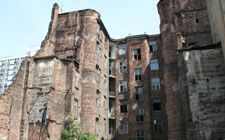 500 tons of high explosive bombs and 72 tons of incendiary bombs were dropped on the city in all. The Germans did not hesitate to bomb civilian targets and hospitals marked with the Red Cross symbol. In the course of the war approximately 84 % of the city was destroyed largely due to German mass bombings but heavy artillery fire was also responsible. 500 tons of high explosive bombs and 72 tons of incendiary bombs were dropped on the city in all. The Germans did not hesitate to bomb civilian targets and hospitals marked with the Red Cross symbol. In the course of the war approximately 84 % of the city was destroyed largely due to German mass bombings but heavy artillery fire was also responsible.
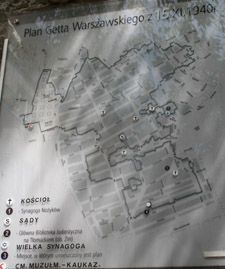 Towards the end of 1940, an area in the central and northern part of the city was designated where all Jewish inhabitants were to be concentrated. Some 350,000 Jews lived in Warsaw prior to WWII, the majority occupying that part of the city where the ghetto was created. Jews who lived in other districts of Warsaw, as well as those who inhabited little towns and villages near the city, were forced to move into the Ghetto. Before the 1942 deportation to the death camp, Treblinka, more than 400,000 Jews were confined in the Warsaw Ghetto; by 1942, 1/3 of this number had died of starvation and disease. Once the whole population of the Ghetto was deported, the district encompassing some 750 acres was leveled to the ground. Towards the end of 1940, an area in the central and northern part of the city was designated where all Jewish inhabitants were to be concentrated. Some 350,000 Jews lived in Warsaw prior to WWII, the majority occupying that part of the city where the ghetto was created. Jews who lived in other districts of Warsaw, as well as those who inhabited little towns and villages near the city, were forced to move into the Ghetto. Before the 1942 deportation to the death camp, Treblinka, more than 400,000 Jews were confined in the Warsaw Ghetto; by 1942, 1/3 of this number had died of starvation and disease. Once the whole population of the Ghetto was deported, the district encompassing some 750 acres was leveled to the ground.
 The Warsaw Ghetto Wall, which was about 10 feet high and 10 miles in total length, separated the Jewish district from the rest of the city. Any Jews outside of the ghetto could have only survived with help from the Poles. It is estimated that some 20,000 Warsaw Jews used that help and managed to survive the war in Nazi-occupied Warsaw. A piece of the Ghetto Wall is preserved in a courtyard between Zlota and Sienna Streets. Since the late 70’s local resident and army veteran Mieczyslaw Jedruszczak has fought to preserve the historical site from being a victim of urban expansion. The Warsaw Ghetto Wall, which was about 10 feet high and 10 miles in total length, separated the Jewish district from the rest of the city. Any Jews outside of the ghetto could have only survived with help from the Poles. It is estimated that some 20,000 Warsaw Jews used that help and managed to survive the war in Nazi-occupied Warsaw. A piece of the Ghetto Wall is preserved in a courtyard between Zlota and Sienna Streets. Since the late 70’s local resident and army veteran Mieczyslaw Jedruszczak has fought to preserve the historical site from being a victim of urban expansion.
In the summer of 1942, about 300,000 Jews were deported from Warsaw to Treblinka When reports of mass murder in the killing center leaked back to the Warsaw Ghetto, a surviving group of mostly young people formed an organization called the Z.O.B. (for the Polish name, Zydowska Organizacja Bojowa, which means Jewish Fighting Organization). The Z.O.B., led by 23-year-old Mordecai Anielewicz, issued a proclamation calling for the Jewish people to resist going to the railroad cars. In January 1943, Warsaw Ghetto Fighters fired upon German troops as they tried to round up another group of ghetto inhabitants for deportation. Fighters used a small supply of weapons that had been smuggled into the Ghetto. After a few days, the troops retreated. This small victory inspired the ghetto fighters to prepare for future resistance.
On April 19, 1943, the Warsaw Ghetto Uprising began after German troops and police entered the ghetto to deport its surviving inhabitants. Seven hundred and fifty fighters fought the heavily armed and well-trained Germans. The Ghetto Fighters were able to hold out for nearly a month, but on May 16, 1943, the revolt ended. The Germans had slowly crushed the resistance. Of the more than 56,000 Jews captured, about 7,000 were shot, and the remainder were deported to killing centers or concentration camps.
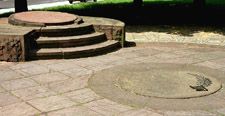 The first WWII Memorial built in Warsaw in 1946 marked the 3rd anniversary of the Ghetto Uprising. The memorial by Lean Marek Suzin marks the spot where the armed confrontation began and faces what was once a gate into the Ghetto. A red sandstone disk tilts forward, facing the now nonexistent gate through which German tanks tried to enter the Ghetto. Over the years of urban renewal the former meaning of the site has been lost. Today erroneous interpretation claims it being in the form of a sewer entrance, like those used by Ghetto Fighters to escape the Ghetto. This kind of loss of meaning and interpretive distortion of a memorial is the fate all sites of commemoration face when several generations pass and urban legends begin to have more place in the public consciousness than the actual history itself. Questions hang in the air of how to preserve the historical accuracy of a site of commemoration as well as how do you revive the historical accuracy of a site that has been subjected to years of unchallenged erroneous promotion. The first WWII Memorial built in Warsaw in 1946 marked the 3rd anniversary of the Ghetto Uprising. The memorial by Lean Marek Suzin marks the spot where the armed confrontation began and faces what was once a gate into the Ghetto. A red sandstone disk tilts forward, facing the now nonexistent gate through which German tanks tried to enter the Ghetto. Over the years of urban renewal the former meaning of the site has been lost. Today erroneous interpretation claims it being in the form of a sewer entrance, like those used by Ghetto Fighters to escape the Ghetto. This kind of loss of meaning and interpretive distortion of a memorial is the fate all sites of commemoration face when several generations pass and urban legends begin to have more place in the public consciousness than the actual history itself. Questions hang in the air of how to preserve the historical accuracy of a site of commemoration as well as how do you revive the historical accuracy of a site that has been subjected to years of unchallenged erroneous promotion.
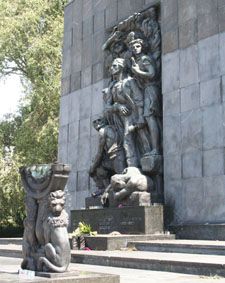 This famous Monument to the Ghetto Heroes, designed by Nathan Rapoport (b. 1911), was unveiled on April 19, 1948, in Warsaw, Poland. The central bronze panel depicts the men, women and children of the ghetto bearing arms in front of a backdrop of the burning Ghetto. Mordechai Anielewicz, the leader of the revolt, stands in the center of the figures to ignite the spirit of rebellion with the torch he clutches in his left hand. The stone used in this memorial was originally quarried for a Nazi victory monument. It has become the recognized icon of memorialization to the Ghetto Uprising, dwarfing all others. Its inscription, “The Jewish Nation – to its fighters and martyrs,” distinctly sent the message that the resistance and struggle are what one should remember from the story of the Ghetto, not the mass destruction of hundreds of thousands of Ghetto victims. This approach relegates mass murder to a secondary role ~ a minimized Polish role as accused Nazi collaborators. This famous Monument to the Ghetto Heroes, designed by Nathan Rapoport (b. 1911), was unveiled on April 19, 1948, in Warsaw, Poland. The central bronze panel depicts the men, women and children of the ghetto bearing arms in front of a backdrop of the burning Ghetto. Mordechai Anielewicz, the leader of the revolt, stands in the center of the figures to ignite the spirit of rebellion with the torch he clutches in his left hand. The stone used in this memorial was originally quarried for a Nazi victory monument. It has become the recognized icon of memorialization to the Ghetto Uprising, dwarfing all others. Its inscription, “The Jewish Nation – to its fighters and martyrs,” distinctly sent the message that the resistance and struggle are what one should remember from the story of the Ghetto, not the mass destruction of hundreds of thousands of Ghetto victims. This approach relegates mass murder to a secondary role ~ a minimized Polish role as accused Nazi collaborators.
 18 Mila Street was the approximate site where Mordechai Anielewicz and the Jewish Fighter's Organization's command committed mass suicide rather than be captured by the Nazis. This memorial mound was erected on the site at a level equal to the level of the wartime rubble in the Ghetto. It is now a favorite spot for snow sledders in the winter. At the bottom of the steps, a marker in English compliments the original three languages of Polish, Yiddish, and Hebrew on the marker. The English reads: "Grave of the Fighters of the Warsaw Ghetto Uprising built from the rubble of Mila Street, one of the liveliest streets of pre-war Jewish Warsaw. These ruins of the bunker at 18 Mila Street are the place of rest of the . . . 18 Mila Street was the approximate site where Mordechai Anielewicz and the Jewish Fighter's Organization's command committed mass suicide rather than be captured by the Nazis. This memorial mound was erected on the site at a level equal to the level of the wartime rubble in the Ghetto. It is now a favorite spot for snow sledders in the winter. At the bottom of the steps, a marker in English compliments the original three languages of Polish, Yiddish, and Hebrew on the marker. The English reads: "Grave of the Fighters of the Warsaw Ghetto Uprising built from the rubble of Mila Street, one of the liveliest streets of pre-war Jewish Warsaw. These ruins of the bunker at 18 Mila Street are the place of rest of the . . .
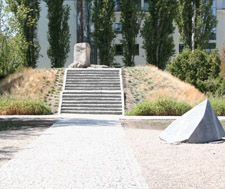 . . . commanders and fighters of the Jewish Combat Organization as well as some civilians. Among them lies Mordechai Anielewicz, the commander in chief on May 18, 1943, surrounded by the Nazis after three weeks of struggle, many perished or took their own lives, refusing to perish at the hands of their enemies. There were several hundred bunkers built in the Ghetto, found and destroyed by the Nazis. They became graves. They could not save those who sought refuge inside them, yet they remain everlasting symbols of the Warsaw Jews' will to live. The bunker at Mila Street was the largest in the ghetto. It is the place of rest of over one hundred fighters, only some of whom are known by name. Here they rest, buried where they fell, to remind us that the whole earth is their grave." . . . commanders and fighters of the Jewish Combat Organization as well as some civilians. Among them lies Mordechai Anielewicz, the commander in chief on May 18, 1943, surrounded by the Nazis after three weeks of struggle, many perished or took their own lives, refusing to perish at the hands of their enemies. There were several hundred bunkers built in the Ghetto, found and destroyed by the Nazis. They became graves. They could not save those who sought refuge inside them, yet they remain everlasting symbols of the Warsaw Jews' will to live. The bunker at Mila Street was the largest in the ghetto. It is the place of rest of over one hundred fighters, only some of whom are known by name. Here they rest, buried where they fell, to remind us that the whole earth is their grave."
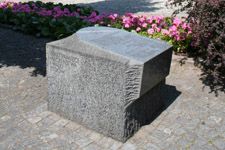 In 1983, as part of commemorative events for the 40th anniversary of the Uprising, the Polish Government gave official approval to the project titled Memorial Route of Jewish Martyrdom and Struggle, which was unveiled in 1988, on the 45th anniversary of the Ghetto Uprising. It consists of 19 one meter high, black stenite blocks spread out between the Rapoport Ghetto Fighter's Monument and the Umschlagplatz, the place of deportation; it also includes two commemorative plaques on the former buildings of SS headquarters and the Jewish hospital; and a new Umschlagplatz Memorial. Each block commemorates a person connected with the Ghetto, such as poets, fighters, or religious leaders. Walking this route and reading the memorial plaques allows visitors to experience a more personal touch of memorialization that gives names to victims and details of their fate, leading them to the new Umschlagplatz Memorial. In 1983, as part of commemorative events for the 40th anniversary of the Uprising, the Polish Government gave official approval to the project titled Memorial Route of Jewish Martyrdom and Struggle, which was unveiled in 1988, on the 45th anniversary of the Ghetto Uprising. It consists of 19 one meter high, black stenite blocks spread out between the Rapoport Ghetto Fighter's Monument and the Umschlagplatz, the place of deportation; it also includes two commemorative plaques on the former buildings of SS headquarters and the Jewish hospital; and a new Umschlagplatz Memorial. Each block commemorates a person connected with the Ghetto, such as poets, fighters, or religious leaders. Walking this route and reading the memorial plaques allows visitors to experience a more personal touch of memorialization that gives names to victims and details of their fate, leading them to the new Umschlagplatz Memorial.
 The new Umschlagplatz Memorial, constructed in 1988, replaced the first Umschlagplatz Memorial Plaque that was placed on the wall of the loading dock railroad platform from which 350,000 Jews from the Ghetto were deported to Treblinka. It read in 3 languages: “This is the gate through which hundreds of thousands of Warsaw Jews, victims of Nazi genocide from 1942 to 1943, went to martyrs’ deaths in exterminations camps.” The new memorial is an enclosure in white marble, with a narrow entrance capped by a black bas-relief representing a forest of felled trees. Facing that entrance, a gap in the opposite wall opens up to a view of a living tree. On the inner walls of the memorial are engraved several hundred names of the first Ghetto victims deported to Treblinka. This is a distinct shift from the monumental heroic theme of Holocaust memory in Warsaw to a more human size personal connection. The new Umschlagplatz Memorial, constructed in 1988, replaced the first Umschlagplatz Memorial Plaque that was placed on the wall of the loading dock railroad platform from which 350,000 Jews from the Ghetto were deported to Treblinka. It read in 3 languages: “This is the gate through which hundreds of thousands of Warsaw Jews, victims of Nazi genocide from 1942 to 1943, went to martyrs’ deaths in exterminations camps.” The new memorial is an enclosure in white marble, with a narrow entrance capped by a black bas-relief representing a forest of felled trees. Facing that entrance, a gap in the opposite wall opens up to a view of a living tree. On the inner walls of the memorial are engraved several hundred names of the first Ghetto victims deported to Treblinka. This is a distinct shift from the monumental heroic theme of Holocaust memory in Warsaw to a more human size personal connection.
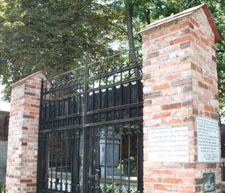 When entering the Jewish Okopoxa Cemetery in Warsaw, one immediately sees this restoration of the original gate of the Jewish Cemetery, renovated in 1998 by the Gesia Foundation, "In Honor of the late Moises Karwasser and in Eternal Memory of the Six Million Jews that were murdered by the Nazi Regime during the Holocaust. In celebration of their lives, we dedicate this gate - with the generous support of Arick and Lauren K. Karwasser and their children." Memorials by family members to Holocaust victims are prevalent on the grounds. When entering the Jewish Okopoxa Cemetery in Warsaw, one immediately sees this restoration of the original gate of the Jewish Cemetery, renovated in 1998 by the Gesia Foundation, "In Honor of the late Moises Karwasser and in Eternal Memory of the Six Million Jews that were murdered by the Nazi Regime during the Holocaust. In celebration of their lives, we dedicate this gate - with the generous support of Arick and Lauren K. Karwasser and their children." Memorials by family members to Holocaust victims are prevalent on the grounds.
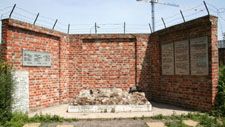 This authentic reproduction of the Warsaw Ghetto Wall, also located in the cemetery, surrounds a memorial "to the one million Jewish Children murdered by Nazi German Barbarians, 1939-1945." The founder/sponsor of the memorial, Jack Eisner, posted his own original poetry on the left side of the monument: "Grandma Masha had twenty grandchildren. Grandma Hana had eleven. Only I survived." These brief words describe the tremendous loss of families that the survivors suffered. The Okopoxa Cemetery is the heart of Jewish life today, with its carefully preserved 100,000 tombstones. Here is buried the community that once was in addition to the mass graves of more than 100,000 of those who perished in the Ghetto. This authentic reproduction of the Warsaw Ghetto Wall, also located in the cemetery, surrounds a memorial "to the one million Jewish Children murdered by Nazi German Barbarians, 1939-1945." The founder/sponsor of the memorial, Jack Eisner, posted his own original poetry on the left side of the monument: "Grandma Masha had twenty grandchildren. Grandma Hana had eleven. Only I survived." These brief words describe the tremendous loss of families that the survivors suffered. The Okopoxa Cemetery is the heart of Jewish life today, with its carefully preserved 100,000 tombstones. Here is buried the community that once was in addition to the mass graves of more than 100,000 of those who perished in the Ghetto.
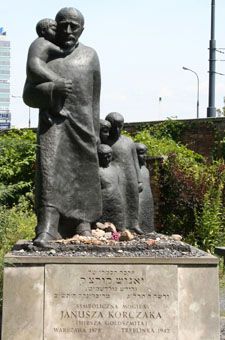 Janusz Korczak, a doctor, educator, and author of children's books, established and ran a Jewish orphanage in Warsaw. After declining offers to be rescued, he marched with his children to Umschlagplatz on August 5, 1942. He did not leave the Ghetto but rather stayed with his children until the very end. He boarded the train at the point of deportation and like thousands of other deportees from the Warsaw Ghetto, died in the gas chambers of Treblinka. This symbolic monument in the Okopoxa Cemetery in Warsaw stands unique, as there are few statues to individuals in the cemetery. Janusz Korczak is the only individual memorialized at the Treblinka Concentration Camp Memorial, where 17,000 granite shards are set in concrete around a 26 foot obelisk. Korczak's name is the only individual's name inscribed on one of the slabs while several hundred others bear names of Polish communities of Jews destroyed in the Shoah. Janusz Korczak, a doctor, educator, and author of children's books, established and ran a Jewish orphanage in Warsaw. After declining offers to be rescued, he marched with his children to Umschlagplatz on August 5, 1942. He did not leave the Ghetto but rather stayed with his children until the very end. He boarded the train at the point of deportation and like thousands of other deportees from the Warsaw Ghetto, died in the gas chambers of Treblinka. This symbolic monument in the Okopoxa Cemetery in Warsaw stands unique, as there are few statues to individuals in the cemetery. Janusz Korczak is the only individual memorialized at the Treblinka Concentration Camp Memorial, where 17,000 granite shards are set in concrete around a 26 foot obelisk. Korczak's name is the only individual's name inscribed on one of the slabs while several hundred others bear names of Polish communities of Jews destroyed in the Shoah.
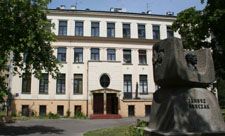 In 1912, Korczak established a Jewish Orphanage, Dom Sierot, in this building which he designed to advance his progressive educational theories. He envisioned a world in which children structured their own world and became experts in their own matters. Jewish children between the ages of seven and fourteen were allowed to live here while attending Polish public school and government-sponsored Jewish schools, known as "Sabbath" schools. The orphanage opened a summer camp in 1921, which remained in operation until the summer of 1940. In 1912, Korczak established a Jewish Orphanage, Dom Sierot, in this building which he designed to advance his progressive educational theories. He envisioned a world in which children structured their own world and became experts in their own matters. Jewish children between the ages of seven and fourteen were allowed to live here while attending Polish public school and government-sponsored Jewish schools, known as "Sabbath" schools. The orphanage opened a summer camp in 1921, which remained in operation until the summer of 1940.
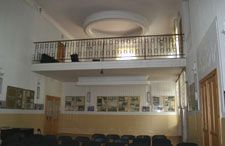 Besides serving as principal of Dom Sierot and another orphanage, Nasz Dom, Korczak was also a doctor and author, worked at a Polish radio station, was a principal of an experimental school, published a children’s newspaper and was a docent at a Polish university. Korczak also served as an expert witness in a district court for minors. He became well-known in Polish society and received many awards. The rise of anti-Semitism in the 1930's restricted only his activities with Jews. His life's story is exhibited through photographs and documents that encircle the main hall of his beautifully restored orphanage in Warsaw. Besides serving as principal of Dom Sierot and another orphanage, Nasz Dom, Korczak was also a doctor and author, worked at a Polish radio station, was a principal of an experimental school, published a children’s newspaper and was a docent at a Polish university. Korczak also served as an expert witness in a district court for minors. He became well-known in Polish society and received many awards. The rise of anti-Semitism in the 1930's restricted only his activities with Jews. His life's story is exhibited through photographs and documents that encircle the main hall of his beautifully restored orphanage in Warsaw.
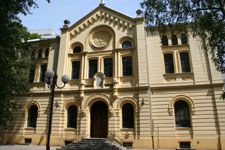 Founded in 1902 by Zalman Nozyk and his wife, the Nozyk Synagogue in Warsaw was devastated during World War II. During the occupation, the synagogue was used by the Nazis for a stable and fodder storage, thus causing considerable damage. Bombardments of the city during the Warsaw Uprising in 1944 caused severe damage to the roof and part of the elevation. It was renovated after the war and, with financial help from the Polish government, later reconstructed between 1977 and 1983. The Nozyk Synagogue still holds services on the Sabbath and Jewish holidays. To view a short video clip of the synagogue, click here ---->Nozyk<.----. Founded in 1902 by Zalman Nozyk and his wife, the Nozyk Synagogue in Warsaw was devastated during World War II. During the occupation, the synagogue was used by the Nazis for a stable and fodder storage, thus causing considerable damage. Bombardments of the city during the Warsaw Uprising in 1944 caused severe damage to the roof and part of the elevation. It was renovated after the war and, with financial help from the Polish government, later reconstructed between 1977 and 1983. The Nozyk Synagogue still holds services on the Sabbath and Jewish holidays. To view a short video clip of the synagogue, click here ---->Nozyk<.----.
 The Nozyk Synagogue is located at number 6 Twarda Street in an area of Warsaw that was originally inside the Little Ghetto in 1940, but was later outside the Ghetto after it was made smaller, following deportations. The Nozyk Synagogue is the only synagogue in Warsaw that survived the war. This beautiful restored remnant of pre-WWII Jewish Warsaw is another reminder of the missing millions, many of whom filled this temple. Today there are only about 5,000 Jews living openly as Jews in Warsaw, mostly elderly, and also perhaps 20,000 to 50,000 hiding their Jewishness. Warsaw is now the city of monuments, built to the memory of its Jewish past that can never be reclaimed. Once a country sheltering the largest population of Jews in Europe, Poland became the harbinger of the Nazi death camps, the sites of devastating destruction of Eastern European Jewry. The following camps are presented below: Majdanek, Belzec, Auschwitz I, Auschwitz II Birkenau, Plaszow, and Theresienstadt, previously Terezin in the Czech Republic. The Nozyk Synagogue is located at number 6 Twarda Street in an area of Warsaw that was originally inside the Little Ghetto in 1940, but was later outside the Ghetto after it was made smaller, following deportations. The Nozyk Synagogue is the only synagogue in Warsaw that survived the war. This beautiful restored remnant of pre-WWII Jewish Warsaw is another reminder of the missing millions, many of whom filled this temple. Today there are only about 5,000 Jews living openly as Jews in Warsaw, mostly elderly, and also perhaps 20,000 to 50,000 hiding their Jewishness. Warsaw is now the city of monuments, built to the memory of its Jewish past that can never be reclaimed. Once a country sheltering the largest population of Jews in Europe, Poland became the harbinger of the Nazi death camps, the sites of devastating destruction of Eastern European Jewry. The following camps are presented below: Majdanek, Belzec, Auschwitz I, Auschwitz II Birkenau, Plaszow, and Theresienstadt, previously Terezin in the Czech Republic.
Return to top of page

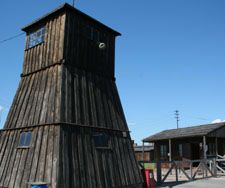 At the end of July 1941, Heinrich Himmler decided on the foundation of a concentration camp in Lublin called, Majdanek, becoming the eastern most camp at that time.The early plans envisioned a camp size large enough to house 250,000 prisoners at one time. These grandiose plans were curtailed when German war difficulties arose resulting in only 1/5 of the original plans being realized between 1941 and 1944. The camp was composed of prisoner barracks, workshops, administration buildings, mass murder installations – gas chambers and crematorium, security-fencing, watchtowers, and sentry boxes. At the end of July 1941, Heinrich Himmler decided on the foundation of a concentration camp in Lublin called, Majdanek, becoming the eastern most camp at that time.The early plans envisioned a camp size large enough to house 250,000 prisoners at one time. These grandiose plans were curtailed when German war difficulties arose resulting in only 1/5 of the original plans being realized between 1941 and 1944. The camp was composed of prisoner barracks, workshops, administration buildings, mass murder installations – gas chambers and crematorium, security-fencing, watchtowers, and sentry boxes.
 Like other concentration camps, Majdanek had its branch and subsidiary camps and labor detachments for work outside the camp. The first prisoners at Majdanek were Russian POWs brought from a camp in Chelm. From the early days of Majdanek, transports of prisoners were coming in from other camps – from Auschwitz, Dachau, Sachsenhausen, Buchenwald, Dora, Ravensbrück, Flossenbürg, and Neuengamme. At the turn of 1941-1942, Majdanek became the center of detention for Jews from Lublin and its surrounding areas. Transports of Jews on a massive scale then began arriving in April 1942, first from Slovakia and the Czech Republic and then from other countries: Austria, Germany, France, Belgium, and Holland. From mid 1942 to mid 1943 transports from the Ghettos in Lublin, Warsaw, and Bialystok predominated. For them, Majdanek was both a concentration camp and a death camp. Like other concentration camps, Majdanek had its branch and subsidiary camps and labor detachments for work outside the camp. The first prisoners at Majdanek were Russian POWs brought from a camp in Chelm. From the early days of Majdanek, transports of prisoners were coming in from other camps – from Auschwitz, Dachau, Sachsenhausen, Buchenwald, Dora, Ravensbrück, Flossenbürg, and Neuengamme. At the turn of 1941-1942, Majdanek became the center of detention for Jews from Lublin and its surrounding areas. Transports of Jews on a massive scale then began arriving in April 1942, first from Slovakia and the Czech Republic and then from other countries: Austria, Germany, France, Belgium, and Holland. From mid 1942 to mid 1943 transports from the Ghettos in Lublin, Warsaw, and Bialystok predominated. For them, Majdanek was both a concentration camp and a death camp.
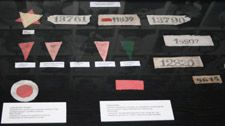 Overall, there were about 300,000 prisoners brought to Majdanek of over 50 nationalities. Jews constituted the most numerous group there, 41%, Polish prisoners coming in second, 35%. In Majdanek, there was no continuous numeration as in other camps, but rather a rotation of numbers. When the figure reached 20,000, the newcomers received the numbers left vacant by the dead or those released from the camp. In addition, markings were used to show the reason of imprisonment and the nationality. This was accomplished by the infamous triangles of different colors, seen here in a display case in one of the exhibit barracks. Overall, there were about 300,000 prisoners brought to Majdanek of over 50 nationalities. Jews constituted the most numerous group there, 41%, Polish prisoners coming in second, 35%. In Majdanek, there was no continuous numeration as in other camps, but rather a rotation of numbers. When the figure reached 20,000, the newcomers received the numbers left vacant by the dead or those released from the camp. In addition, markings were used to show the reason of imprisonment and the nationality. This was accomplished by the infamous triangles of different colors, seen here in a display case in one of the exhibit barracks.
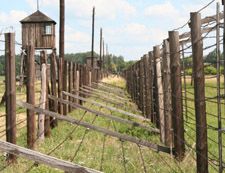 Prisoner barracks divided into fields were the central part of the camp. Each field was a rectangle surrounded by a double line of barbed wire fence equipped with high voltage installations. Around the 6 fields were raised 18 watchtowers where the SS stood on duty day and night. Every field had 24 barracks in two rows with a roll call square and a gallows in the middle. Outside the rectangle of the fields stood mass murder installations, workshops and storage barracks, SS living quarters and the commandant’s lodgings. Prisoner barracks divided into fields were the central part of the camp. Each field was a rectangle surrounded by a double line of barbed wire fence equipped with high voltage installations. Around the 6 fields were raised 18 watchtowers where the SS stood on duty day and night. Every field had 24 barracks in two rows with a roll call square and a gallows in the middle. Outside the rectangle of the fields stood mass murder installations, workshops and storage barracks, SS living quarters and the commandant’s lodgings.
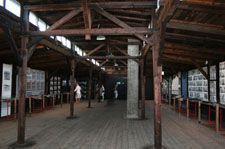 The decision to set up a Museum at Majdanek was made as early as the autumn of 1944 with the organization of the Society for the Preservation of Majdanek. Visitations began in November 1944 and it was the first museum to operate on the site of a former camp. The main aims of the museum are: maintain and manage the area of the former camp, with its buildings and installations; collect and research the relics of the camp and archive materials documenting its history; research the problems that refer to the camp; disseminate knowledge on Majdanek by means of exhibitions, publications, and educational projects; collect art on anti-war themes and exhibit it; and utilize the tragic experiences of the past for education in the spirit of unity between nations. The decision to set up a Museum at Majdanek was made as early as the autumn of 1944 with the organization of the Society for the Preservation of Majdanek. Visitations began in November 1944 and it was the first museum to operate on the site of a former camp. The main aims of the museum are: maintain and manage the area of the former camp, with its buildings and installations; collect and research the relics of the camp and archive materials documenting its history; research the problems that refer to the camp; disseminate knowledge on Majdanek by means of exhibitions, publications, and educational projects; collect art on anti-war themes and exhibit it; and utilize the tragic experiences of the past for education in the spirit of unity between nations.
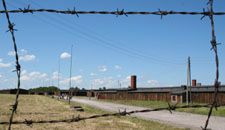 At the site of the former camp today are preserved the barracks in Field III, fencing of five fields and the watchtowers. Also still standing are the gas chambers next to Field I and the reconstructed crematorium beyond Field V. Most of the workshops built along side the road way are used today as exhibition areas. The area of the former camp and all that remained of the camp site were given over to the State Museum of Majdanek by the Republic of Poland on July 2, 1947 so that it could be preserved for all times as the Monument to Martyrdom. At the site of the former camp today are preserved the barracks in Field III, fencing of five fields and the watchtowers. Also still standing are the gas chambers next to Field I and the reconstructed crematorium beyond Field V. Most of the workshops built along side the road way are used today as exhibition areas. The area of the former camp and all that remained of the camp site were given over to the State Museum of Majdanek by the Republic of Poland on July 2, 1947 so that it could be preserved for all times as the Monument to Martyrdom.
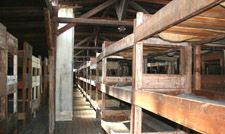 During its years of operation, the living conditions at Majdanek were primitive at best. The thin cotton striped uniforms provided no protection from the rain and snow and inmates remained wet and often froze to death. In the early years of the camp, prisoners slept on straw spread over bare ground. Later, floors were put in and three-tier plank beds without mattresses were filled with straw and wood shavings instead. Typhoid epidemics, diarrhea, tuberculosis, dysentery, scurvy, scabies and mental disorders raged due to the ever deteriorating sanitary conditions, malnutrition, lice, and rodents. During its years of operation, the living conditions at Majdanek were primitive at best. The thin cotton striped uniforms provided no protection from the rain and snow and inmates remained wet and often froze to death. In the early years of the camp, prisoners slept on straw spread over bare ground. Later, floors were put in and three-tier plank beds without mattresses were filled with straw and wood shavings instead. Typhoid epidemics, diarrhea, tuberculosis, dysentery, scurvy, scabies and mental disorders raged due to the ever deteriorating sanitary conditions, malnutrition, lice, and rodents.
 Prisoners were exposed not only to accelerated “natural” death, but also experienced direct genocide in the forms of executions and gassings on a mass scale. Gas chambers were in use at Majdanek from mid 1942. Over the entrance door it read “Bath and Disinfection” to lull the victims into compliance. Prisoners were exposed not only to accelerated “natural” death, but also experienced direct genocide in the forms of executions and gassings on a mass scale. Gas chambers were in use at Majdanek from mid 1942. Over the entrance door it read “Bath and Disinfection” to lull the victims into compliance.
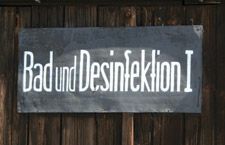 The victims were mainly Jews selected for death directly upon arrival. Other forms of executions were hanging, clubbing and beatings, strangulation, and drowning in water reservoirs and cesspits. Of the 235,000 victims of Majdanek, 48% were Jews, 31% were Poles, 16% were from the Soviet Union, and the remainder came from all other nationalities. The victims were mainly Jews selected for death directly upon arrival. Other forms of executions were hanging, clubbing and beatings, strangulation, and drowning in water reservoirs and cesspits. Of the 235,000 victims of Majdanek, 48% were Jews, 31% were Poles, 16% were from the Soviet Union, and the remainder came from all other nationalities.
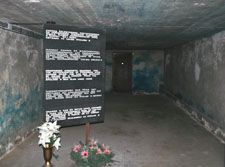 These walls bear witness to the use of Zyklon- B for exterminations in the blue stains from the crystals embedded in the sides of the walls. This reinforced concrete chamber also used carbon monoxide, a gas that was supplied by means of a conduit from the SS guard booth. The first corpses were buried in collective graves and from mid 1942 they were burned in the crematorium and on pyres. These walls bear witness to the use of Zyklon- B for exterminations in the blue stains from the crystals embedded in the sides of the walls. This reinforced concrete chamber also used carbon monoxide, a gas that was supplied by means of a conduit from the SS guard booth. The first corpses were buried in collective graves and from mid 1942 they were burned in the crematorium and on pyres.
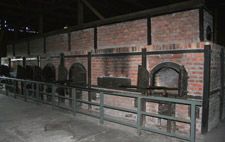 In the first crematorium, two furnaces burning crude oil had a capacity of 200 bodies per day. To facilitate greater numbers of bodies burning hotter and faster, this new crematorium, designed by the Berlin firm of K. Kori, had five stoves and burned coal. Of the 300,000 prisoners interned at Majdanek, 235,000 died at Majdanek. 45,000 were transferred to other camps, 20,000 were released, and only 1500 were liberated. In the first crematorium, two furnaces burning crude oil had a capacity of 200 bodies per day. To facilitate greater numbers of bodies burning hotter and faster, this new crematorium, designed by the Berlin firm of K. Kori, had five stoves and burned coal. Of the 300,000 prisoners interned at Majdanek, 235,000 died at Majdanek. 45,000 were transferred to other camps, 20,000 were released, and only 1500 were liberated.
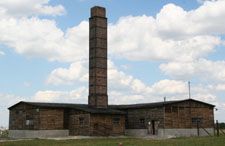 This building, which houses the ovens above, is a reconstruction for site preservation purposes. The original crematoriums were set afire by the Germans when they abandoned the camp to the advancing Soviet army. The original brick ovens were restored and the wooden structure rebuilt. Curators felt it important to portray the crematorium that had incinerated thousands of Majdanek victims in its original setting. This building, which houses the ovens above, is a reconstruction for site preservation purposes. The original crematoriums were set afire by the Germans when they abandoned the camp to the advancing Soviet army. The original brick ovens were restored and the wooden structure rebuilt. Curators felt it important to portray the crematorium that had incinerated thousands of Majdanek victims in its original setting.
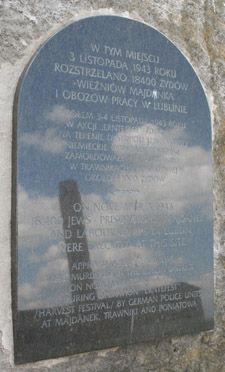 The largest single execution took place on November 3, 1943, when 18,000 Jews were shot. The mass shooting was the final stage in the liquidation of Jews in Lublin. Three rows of deep ditches had been dug near the crematorium. Taken to the ditches and stripped naked, victims had to lie down in the ditches and the SS machine-gunned them from the top of the ditch. Others then had to line up, lie down on top of the corpses and then were shot in the same manner. The shooting of rows and rows of inmates continued until the ditches were filled to the brim. The action lasted without break from morning till evening, while music played from car radios equipped with loud speakers, to deaden the cacophony of the crime. The corpses were incinerated on pyres arranged on the iron chassis of old lorries. The human ashes that remained were mixed with kitchen scraps and earth to make compost and then used as fertilizer in the fields and gardens of the camp. The largest single execution took place on November 3, 1943, when 18,000 Jews were shot. The mass shooting was the final stage in the liquidation of Jews in Lublin. Three rows of deep ditches had been dug near the crematorium. Taken to the ditches and stripped naked, victims had to lie down in the ditches and the SS machine-gunned them from the top of the ditch. Others then had to line up, lie down on top of the corpses and then were shot in the same manner. The shooting of rows and rows of inmates continued until the ditches were filled to the brim. The action lasted without break from morning till evening, while music played from car radios equipped with loud speakers, to deaden the cacophony of the crime. The corpses were incinerated on pyres arranged on the iron chassis of old lorries. The human ashes that remained were mixed with kitchen scraps and earth to make compost and then used as fertilizer in the fields and gardens of the camp.
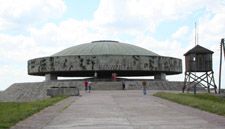 After liberation, mounds of human compost still remained and have been enshrined in the Memorial Mausoleum built on the site of the execution ditches. In 1969 two monumental structures were erected that made up the Monument of Struggle and Martyrdom and the Mausoleum. The Monument looms at one end of the Road of Homage and the Mausoleum hovers at the other. The Mausoleum is a huge circular urn with a Dome resting on columns containing the ashes of murdered victims. After liberation, mounds of human compost still remained and have been enshrined in the Memorial Mausoleum built on the site of the execution ditches. In 1969 two monumental structures were erected that made up the Monument of Struggle and Martyrdom and the Mausoleum. The Monument looms at one end of the Road of Homage and the Mausoleum hovers at the other. The Mausoleum is a huge circular urn with a Dome resting on columns containing the ashes of murdered victims.
 An inscription reads: “Let our fate be a warning to you.” In this picture, you can see the rising mound of human mulch in the center of the structure. There is no other site of Holocaust memorialization that had quite the same impact on my sensibilities as did seeing this huge mound of human dust. An inscription reads: “Let our fate be a warning to you.” In this picture, you can see the rising mound of human mulch in the center of the structure. There is no other site of Holocaust memorialization that had quite the same impact on my sensibilities as did seeing this huge mound of human dust.
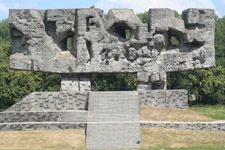 The Monument of Struggle and Martyrdom appears as a colossal gate made of stone and concrete that marks the entrance to the Majdanek Concentration Camp site. Majdanek was the first Nazi concentration / death camp I had ever visited and its impact on me was massive, much like this huge monument - indefinable, unexplainable, yet very, VERY real. The Monument of Struggle and Martyrdom appears as a colossal gate made of stone and concrete that marks the entrance to the Majdanek Concentration Camp site. Majdanek was the first Nazi concentration / death camp I had ever visited and its impact on me was massive, much like this huge monument - indefinable, unexplainable, yet very, VERY real.
Return to top of page

 Immediately following the decision of the Nazis to implement “Aktion Reinhardt,” the Germans began construction of three death camps in Poland designed for the purpose of exterminating the Jews living in the region known as the “General -Gouvernement.” On November 1, 1941, Belzec, the first of the three death camps, the others being Treblinka and Sobibor, was the first death camp in which the Nazis used stationary gas chambers for killing their victims. The annihilation of the Jews at Belzec lasted for only nine months between March and December of 1942, but in that time over ½ a million exterminations took place, mostly Polish and foreign Jews, and small groups of non-Jewish Poles and Gypsies. Corpses were buried in about 30 mass graves located within the perimeter of the camp site, which was at most 400 meters square. It was this practice of mass burials within the camp areas itself that caused the Germans to abandon the camp when the Fall and Winter weather caused the bodies of the buried to swell and literally push themselves up out of the ground. This presented great health dangers for the perpetrators. When cremation pyres could not incinerate the bodies fast enough, abandonment was the only "healthy" alternative for the camp personnel. Immediately following the decision of the Nazis to implement “Aktion Reinhardt,” the Germans began construction of three death camps in Poland designed for the purpose of exterminating the Jews living in the region known as the “General -Gouvernement.” On November 1, 1941, Belzec, the first of the three death camps, the others being Treblinka and Sobibor, was the first death camp in which the Nazis used stationary gas chambers for killing their victims. The annihilation of the Jews at Belzec lasted for only nine months between March and December of 1942, but in that time over ½ a million exterminations took place, mostly Polish and foreign Jews, and small groups of non-Jewish Poles and Gypsies. Corpses were buried in about 30 mass graves located within the perimeter of the camp site, which was at most 400 meters square. It was this practice of mass burials within the camp areas itself that caused the Germans to abandon the camp when the Fall and Winter weather caused the bodies of the buried to swell and literally push themselves up out of the ground. This presented great health dangers for the perpetrators. When cremation pyres could not incinerate the bodies fast enough, abandonment was the only "healthy" alternative for the camp personnel.
 For many years Belzec was the most forgotten camp of the Holocaust. The New Memorial at the site of the camp was designed by Andrzej Solyga, Zdzislaw Pidek, and Marcin Roszczyk and opened on June 3, 2004 as a joint project of the American Jewish Committee and the Council for the Protection of the Memory of Combat and Martyrdom in Warsaw. Alan Elsner, journalist and grandson of victims killed at Belzec, can be credited with exposing the disgraceful neglect of the site after his visit to the old memorial in 1993. His reporting prompted the campaign that built this new memorial. I recommend all readers to link to his website, ---->Alan Elsner<.---- where you can read his article about the prior conditions of the site. The complex consists of a memorial to the victims of the camp, a reconstruction of an extermination pyre, and a museum with an exhibition about the history of the Belzec death camp. Click here ----> Belzec Video <.---- to view video clips of the Belzec Memorial site. For many years Belzec was the most forgotten camp of the Holocaust. The New Memorial at the site of the camp was designed by Andrzej Solyga, Zdzislaw Pidek, and Marcin Roszczyk and opened on June 3, 2004 as a joint project of the American Jewish Committee and the Council for the Protection of the Memory of Combat and Martyrdom in Warsaw. Alan Elsner, journalist and grandson of victims killed at Belzec, can be credited with exposing the disgraceful neglect of the site after his visit to the old memorial in 1993. His reporting prompted the campaign that built this new memorial. I recommend all readers to link to his website, ---->Alan Elsner<.---- where you can read his article about the prior conditions of the site. The complex consists of a memorial to the victims of the camp, a reconstruction of an extermination pyre, and a museum with an exhibition about the history of the Belzec death camp. Click here ----> Belzec Video <.---- to view video clips of the Belzec Memorial site.
 A huge field of randomly sized concrete rubble covers the entire camp area of Belzec, with the center path through the site being reminiscent of “Die Schleuse,” (The Sluice) a camouflaged barbed wire path that led from the undressing and barber barracks straight to the gas chambers, which were also camouflaged with netting on raised poles. A huge field of randomly sized concrete rubble covers the entire camp area of Belzec, with the center path through the site being reminiscent of “Die Schleuse,” (The Sluice) a camouflaged barbed wire path that led from the undressing and barber barracks straight to the gas chambers, which were also camouflaged with netting on raised poles.
 The darkly colored areas of the concrete rubble field demarcate the locations of the mass graves. In earlier years, a sculpture had been erected in the 1960s by the former Communist authorities of Poland. Jewish visitors to the site had complained that it was badly neglected, overgrown with weeds and strewn with garbage. They also said the existing memorial was inappropriate and was falling apart. A Polish team then carried out the most comprehensive archeological survey ever conducted on a major Holocaust site and located 33 previously unknown mass graves. According to reports, the survey team bored holes to a depth of 18 feet at 15-yard intervals throughout the site. The darkly colored areas of the concrete rubble field demarcate the locations of the mass graves. In earlier years, a sculpture had been erected in the 1960s by the former Communist authorities of Poland. Jewish visitors to the site had complained that it was badly neglected, overgrown with weeds and strewn with garbage. They also said the existing memorial was inappropriate and was falling apart. A Polish team then carried out the most comprehensive archeological survey ever conducted on a major Holocaust site and located 33 previously unknown mass graves. According to reports, the survey team bored holes to a depth of 18 feet at 15-yard intervals throughout the site.
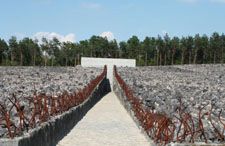 "The largest mass graves ... contained unburned human remains (parts and pieces of skulls with hair and skin attached). The bottom layer of the graves consisted of several inches thick of black human fat. One grave contained uncrushed human bones so closely packed that the drill could not penetrate," wrote Robin O'Neill, member of the survey team. "The largest mass graves ... contained unburned human remains (parts and pieces of skulls with hair and skin attached). The bottom layer of the graves consisted of several inches thick of black human fat. One grave contained uncrushed human bones so closely packed that the drill could not penetrate," wrote Robin O'Neill, member of the survey team.
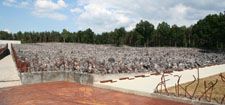 The Nazis had built Belzec to destroy the centuries-old Jewish communities of southern and eastern Poland. In 1942, with that job completed, the Nazis closed the camp.They later tried to hide their crime, burning the bodies and grinding up the bones.The memorial path that completely encircles the entire site bears the names of all the communities of Jewish victims that were murdered at Belzec. The Nazis had built Belzec to destroy the centuries-old Jewish communities of southern and eastern Poland. In 1942, with that job completed, the Nazis closed the camp.They later tried to hide their crime, burning the bodies and grinding up the bones.The memorial path that completely encircles the entire site bears the names of all the communities of Jewish victims that were murdered at Belzec.
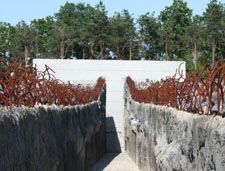 The Interstice cuts through the earth, showing that the camp was built on a slope. The path leading to the granite wall is 600 feet long and the cut through the earth is 30 feet deep. The remains of thousands of unburned bodies were found. Out of respect for the dead, the graves were not opened and the bodies were not exhumed, so no identification was made. Knowing that you are walking through the site of mass graves is one of the more powerful effects of the new memorial at Belzec. The Interstice cuts through the earth, showing that the camp was built on a slope. The path leading to the granite wall is 600 feet long and the cut through the earth is 30 feet deep. The remains of thousands of unburned bodies were found. Out of respect for the dead, the graves were not opened and the bodies were not exhumed, so no identification was made. Knowing that you are walking through the site of mass graves is one of the more powerful effects of the new memorial at Belzec.
 When you get to the end of the path, there is this inscription from The Tanakh, from the Book of Job, in Hebrew, Polish and English: "Earth, do not cover my blood; Let there be no resting place for my outcry." Job 16:18. When you get to the end of the path, there is this inscription from The Tanakh, from the Book of Job, in Hebrew, Polish and English: "Earth, do not cover my blood; Let there be no resting place for my outcry." Job 16:18.
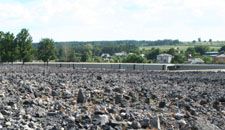 This view is taken from the very farthest back edge of the site, looking down towards the entry and the Belzec Museum that is to your right when you enter the site. The camp seemed both small and confined and yet enormously huge at the same time. I found this abstracted portrayal of Holocaust history to have a powerful effect- every bit as powerful as seeing actual sites, as at Majdanek. This view is taken from the very farthest back edge of the site, looking down towards the entry and the Belzec Museum that is to your right when you enter the site. The camp seemed both small and confined and yet enormously huge at the same time. I found this abstracted portrayal of Holocaust history to have a powerful effect- every bit as powerful as seeing actual sites, as at Majdanek.
 The entrance to the museum duplicates the entrance through the center of the camp, in that you descend into the museum, just as you walked down into the mass grave area of the concrete field. Photographs of families and children, laughing and smiling, tell of Jewish life before the Holocaust. This small museum houses only a few artifacts from the camp, with photographs from Nazi records that tell of the existence of the camp. The entrance to the museum duplicates the entrance through the center of the camp, in that you descend into the museum, just as you walked down into the mass grave area of the concrete field. Photographs of families and children, laughing and smiling, tell of Jewish life before the Holocaust. This small museum houses only a few artifacts from the camp, with photographs from Nazi records that tell of the existence of the camp.
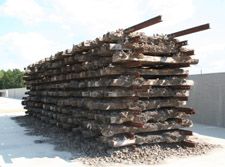 Between December 1942 and April 1943, transports stopped arriving at the camp and during these months, Jewish prisoners had to open the mass graves and burn the bodies of the gassed victims on huge pyres of layered railroad ties. In June 1943, the camp was totally liquidated and all the buildings were destroyed. No significant physical evidence of the victims was ever to be found at the site and the transport lists were also destroyed. The victims of Belzec died in an anonymous mass and only two official survivors of the camp lived to provide post-war testimonies of life and death at Belzec. Between December 1942 and April 1943, transports stopped arriving at the camp and during these months, Jewish prisoners had to open the mass graves and burn the bodies of the gassed victims on huge pyres of layered railroad ties. In June 1943, the camp was totally liquidated and all the buildings were destroyed. No significant physical evidence of the victims was ever to be found at the site and the transport lists were also destroyed. The victims of Belzec died in an anonymous mass and only two official survivors of the camp lived to provide post-war testimonies of life and death at Belzec.
 In the area of the rail ramps where the train cars stopped to unload their human cargo, stands a memorial fashioned after the pyres that were constructed for the burning of the corpses from the mass graves. I was impressed and touched by this memorial site, and felt I had made only a brief connection to the enormity of Belzec's atrocities. In the area of the rail ramps where the train cars stopped to unload their human cargo, stands a memorial fashioned after the pyres that were constructed for the burning of the corpses from the mass graves. I was impressed and touched by this memorial site, and felt I had made only a brief connection to the enormity of Belzec's atrocities.
Return to top of page

 Auschwitz (main camp pictured here) has come to be recognized as the symbol of the Holocaust - the largest and most deadly of all 7000+ camps throughout Europe. The Nazis opened it in 1940 on the outskirts of the Polish city of Oswiecim, which came under German occupation during WWII. The Germans changed the name of the city to "Auschwitz," and this also became the name of the camp. Over the following years, the camp expanded until it comprised three main parts: Auschwitz I, Auschwitz II-Birkenau, and Auschwitz III-Monowitz, along with its 40 sub-camps. At first a place of imprisonment for the Poles and then Soviet POWs, beginning in 1942 the camp became the scene of the largest mass murder in human history, committed against the Jews deported to Auschwitz. It is estimated that the Nazis sent 1.3 million victims to Auschwitz, with at least 1,100,000 of them being Jews from all over Nazi occupied Europe, who were then mercilessly murdered. In an effort to remove the evidence of their crimes, the SS began dismantling or demolishing the gas chambers and the crematoria at Birkenau, along with other buildings at the end of the war. They also burned the records. Nazis then evacuated prisoners capable of walking into the heart of the Third Reich, with many dying on these death marches. Soviet Army soldiers liberated the remaining Auschwitz prisoners, around 7,000, in January 1945. Auschwitz (main camp pictured here) has come to be recognized as the symbol of the Holocaust - the largest and most deadly of all 7000+ camps throughout Europe. The Nazis opened it in 1940 on the outskirts of the Polish city of Oswiecim, which came under German occupation during WWII. The Germans changed the name of the city to "Auschwitz," and this also became the name of the camp. Over the following years, the camp expanded until it comprised three main parts: Auschwitz I, Auschwitz II-Birkenau, and Auschwitz III-Monowitz, along with its 40 sub-camps. At first a place of imprisonment for the Poles and then Soviet POWs, beginning in 1942 the camp became the scene of the largest mass murder in human history, committed against the Jews deported to Auschwitz. It is estimated that the Nazis sent 1.3 million victims to Auschwitz, with at least 1,100,000 of them being Jews from all over Nazi occupied Europe, who were then mercilessly murdered. In an effort to remove the evidence of their crimes, the SS began dismantling or demolishing the gas chambers and the crematoria at Birkenau, along with other buildings at the end of the war. They also burned the records. Nazis then evacuated prisoners capable of walking into the heart of the Third Reich, with many dying on these death marches. Soviet Army soldiers liberated the remaining Auschwitz prisoners, around 7,000, in January 1945.
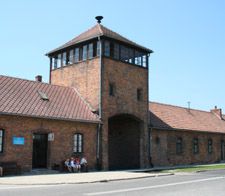 (Auschwitz II - Birkenau pictured here) Several months after the war, a group of Polish prisoners, who had survived Auschwitz, began communicating the idea of commemorating the victims of the largest of the death camps. In April 1946, a group of Polish survivors arrived at the site of the camp with the intention of opening a museum. Thousands of visitors had begun arriving on a mass scale to search for traces of relatives or to pay homage to those who had been murdered. Survivors began acting as unofficial docents to these modern day pilgrims. On July 2, 1947 the Polish Parliament passed a law securing the grounds and buildings of Auschwitz as a place of international martyrdom and calling into being the Oswiecim-Brzezinka State Museum for this purpose.The museum's mission was to secure the grounds and buildings of the camp, and to collect and gather evidence and material related to the Nazi crimes so that they could be studied and made accessible to the public. There are 154 original camp buildings of various sorts in the Museum and Memorial, 56 at Auschwitz I and 98 at Birkenau. These include prisoner blocks and barracks, administration buildings, SS guardhouses, guard towers, and the camp gates. There are also 300 ruins, including the ruins of the gas chambers and crematoria at Birkenau, camp fences, paved roads, and train tracks. Thousands of objects belonging to the camp inmates were found at the site, including suitcases, Jewish prayer garments, artifical limbs, eyeglasses, shoes, and human hair. These objects make up a basic part of the Museum holdings and are on display in the exhibit rooms, housed in the brick barracks of Auschwitz I. Also on exhibit are hundreds of smaller items, such as umbrellas, combs, shaving brushes, toothbrushes, etc. The Museum encompasses 6,000 exhibits, including 2,000 works of art done in the camp by prisoners, often illegally, as well as other works of art produced after the war. The Archives contain a vast collection of Nazi documents, as well as material from the prisoner resistance movement, postwar accounts, memoirs, depositions, films, etc. (Auschwitz II - Birkenau pictured here) Several months after the war, a group of Polish prisoners, who had survived Auschwitz, began communicating the idea of commemorating the victims of the largest of the death camps. In April 1946, a group of Polish survivors arrived at the site of the camp with the intention of opening a museum. Thousands of visitors had begun arriving on a mass scale to search for traces of relatives or to pay homage to those who had been murdered. Survivors began acting as unofficial docents to these modern day pilgrims. On July 2, 1947 the Polish Parliament passed a law securing the grounds and buildings of Auschwitz as a place of international martyrdom and calling into being the Oswiecim-Brzezinka State Museum for this purpose.The museum's mission was to secure the grounds and buildings of the camp, and to collect and gather evidence and material related to the Nazi crimes so that they could be studied and made accessible to the public. There are 154 original camp buildings of various sorts in the Museum and Memorial, 56 at Auschwitz I and 98 at Birkenau. These include prisoner blocks and barracks, administration buildings, SS guardhouses, guard towers, and the camp gates. There are also 300 ruins, including the ruins of the gas chambers and crematoria at Birkenau, camp fences, paved roads, and train tracks. Thousands of objects belonging to the camp inmates were found at the site, including suitcases, Jewish prayer garments, artifical limbs, eyeglasses, shoes, and human hair. These objects make up a basic part of the Museum holdings and are on display in the exhibit rooms, housed in the brick barracks of Auschwitz I. Also on exhibit are hundreds of smaller items, such as umbrellas, combs, shaving brushes, toothbrushes, etc. The Museum encompasses 6,000 exhibits, including 2,000 works of art done in the camp by prisoners, often illegally, as well as other works of art produced after the war. The Archives contain a vast collection of Nazi documents, as well as material from the prisoner resistance movement, postwar accounts, memoirs, depositions, films, etc.
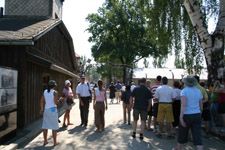 In addition to preservation work, the Museum carries out scholarly research, organizes exhibits, issues its own publications, organizes lectures, conferences, seminars, and symposia for teachers and students, and offers postgraduate course work for education on Totalitarianism, Nazism, and the Holocaust. But the most popular education is carried out among the visitors to the Auschwitz Memorial. An average of 1/2 million people visit Auschwitz every year. This is the most recognized venue and the most publicly witnessed legacy of the Holocaust, therefore it has the greatest impact on the manner is which Holocaust memory will be held in perpetuity. As the methodology of memorialization advances, both in theory and in practice, Auschwitz continues to generate not only admiration for its preservation work, but criticism for its manner and message of commemoration, produced for mass public appeal, often times seen as fulfilling a tourist appeal at the expense of historical analysis. In addition to preservation work, the Museum carries out scholarly research, organizes exhibits, issues its own publications, organizes lectures, conferences, seminars, and symposia for teachers and students, and offers postgraduate course work for education on Totalitarianism, Nazism, and the Holocaust. But the most popular education is carried out among the visitors to the Auschwitz Memorial. An average of 1/2 million people visit Auschwitz every year. This is the most recognized venue and the most publicly witnessed legacy of the Holocaust, therefore it has the greatest impact on the manner is which Holocaust memory will be held in perpetuity. As the methodology of memorialization advances, both in theory and in practice, Auschwitz continues to generate not only admiration for its preservation work, but criticism for its manner and message of commemoration, produced for mass public appeal, often times seen as fulfilling a tourist appeal at the expense of historical analysis.
 The entrance to Auschwitz I, the gate with the infamous inscription, "Arbeit Macht Frei" (work makes you free), appeared as a cruel joke by its inmates. The camp originally had been the barracks of the Polish army, who had abandoned it at the outbreak of WWII. The entrance to Auschwitz I, the gate with the infamous inscription, "Arbeit Macht Frei" (work makes you free), appeared as a cruel joke by its inmates. The camp originally had been the barracks of the Polish army, who had abandoned it at the outbreak of WWII.
 Initially the camp known as Auschwitz I comprised 20 buildings: 14 at ground level and 6 with an upper floor. During the period from 1941 to 1942 an extra storey was added to all ground-floor buildings and 8 new blocks were constructed. Altogether the camp now contained 28 two-story buildings that served as prisoner barracks. The average number of prisoners fluctuated between 13 -16,000, reaching 20,000 at one stage in 1942. My first impression on seeing the massive, red brick buildings was that it looked like an Ivy League College campus on summer break. The initial thought abhorred me that I could see any kind of beauty in a place whose history spoke of such beastly brutality. Initially the camp known as Auschwitz I comprised 20 buildings: 14 at ground level and 6 with an upper floor. During the period from 1941 to 1942 an extra storey was added to all ground-floor buildings and 8 new blocks were constructed. Altogether the camp now contained 28 two-story buildings that served as prisoner barracks. The average number of prisoners fluctuated between 13 -16,000, reaching 20,000 at one stage in 1942. My first impression on seeing the massive, red brick buildings was that it looked like an Ivy League College campus on summer break. The initial thought abhorred me that I could see any kind of beauty in a place whose history spoke of such beastly brutality.
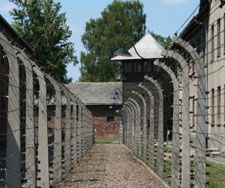 One needed only to turn and see the electric fences and guard towers to know this was no elite college campus. The double rows of electrified barbed wire fencing encircled the entire camp and prevented prisoner escapes. There were cases in which desperate prisoners, unable to bear the terror and torture of Auschwitz any longer, would throw themselves "on the wire" - the term used in the camp to describe suicide by electrocution on the electrically charged fences. One needed only to turn and see the electric fences and guard towers to know this was no elite college campus. The double rows of electrified barbed wire fencing encircled the entire camp and prevented prisoner escapes. There were cases in which desperate prisoners, unable to bear the terror and torture of Auschwitz any longer, would throw themselves "on the wire" - the term used in the camp to describe suicide by electrocution on the electrically charged fences.
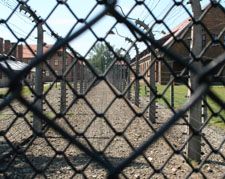 Although I had been to many places of memorialization of the Holocaust, with detailed representations of Auschwitz, such as existed at the USHMM in Wash. DC and Yad Vashem in Israel, my understanding from those experiences could not in any way have matched what I realized and witnessed as I walked the camp itself. It was as if my vision had been constrained by multiple layers of time, distance, and personal experiences, much like this photograph depicts a scene of Auschwitz through obstructing layers of chain-link fencing. One can still see through it, but the perception has been obstructed. And while I believe that the museum exhibits at Wash. DC and Jerusalem are exceptional displays, they can only give their visitors an abstracted view at best. Although I had been to many places of memorialization of the Holocaust, with detailed representations of Auschwitz, such as existed at the USHMM in Wash. DC and Yad Vashem in Israel, my understanding from those experiences could not in any way have matched what I realized and witnessed as I walked the camp itself. It was as if my vision had been constrained by multiple layers of time, distance, and personal experiences, much like this photograph depicts a scene of Auschwitz through obstructing layers of chain-link fencing. One can still see through it, but the perception has been obstructed. And while I believe that the museum exhibits at Wash. DC and Jerusalem are exceptional displays, they can only give their visitors an abstracted view at best.
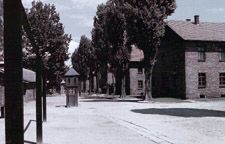 Roll call square with its gallows, seen on the left, is one of the main sites of torture in camp. Roll call often lasted many hours, as inmates were expected to stand without sound or movement, regardless of weather, at penalty of instant beatings and death. Prisoner punishments by hangings served to intimidate the others into compliance to the often arbitrary camp rules that changed on the whim of the perpetrators. Roll call square with its gallows, seen on the left, is one of the main sites of torture in camp. Roll call often lasted many hours, as inmates were expected to stand without sound or movement, regardless of weather, at penalty of instant beatings and death. Prisoner punishments by hangings served to intimidate the others into compliance to the often arbitrary camp rules that changed on the whim of the perpetrators.
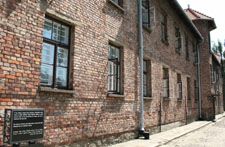 While walking freely among the barracks, trying to have my own moments away from the crowds at Auschwitz and yet not wanting to lose track of the tour group to which I was assigned, this building, with its historical information plaque, told of yet another place of torture and punishment. It seemed that no matter where I went on the grounds, there were always areas commemorated as a place of infamous memory. While walking freely among the barracks, trying to have my own moments away from the crowds at Auschwitz and yet not wanting to lose track of the tour group to which I was assigned, this building, with its historical information plaque, told of yet another place of torture and punishment. It seemed that no matter where I went on the grounds, there were always areas commemorated as a place of infamous memory.
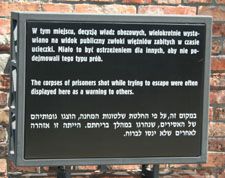 This is an enlargement of the historical information plaque seen against the wall above. It reads: "The corpses of prisoners shot while trying to escape were often displayed here as a warning to others." All historical displays were in three languages, Polish, English, and Hebrew. There was not an excessive presence of these plaques. I felt that their rarity was an intentional choice so as not to encumber the actual sites with obtrusive signs. This is an enlargement of the historical information plaque seen against the wall above. It reads: "The corpses of prisoners shot while trying to escape were often displayed here as a warning to others." All historical displays were in three languages, Polish, English, and Hebrew. There was not an excessive presence of these plaques. I felt that their rarity was an intentional choice so as not to encumber the actual sites with obtrusive signs.
 Another form of exhibit seen on the grounds of Auschwitz are historical photographs displaying scenes from actual daily life, such as this picture of the orchestra set up on a small square by the kitchen. The verbiage for this photograph reads: "The camp orchestra had to assemble here to play marches while prisoners filed past. This was to help prisoners' keep in step and make it easier to count them as they went to and from work." Photo from the SS photo archives, 1941. Another form of exhibit seen on the grounds of Auschwitz are historical photographs displaying scenes from actual daily life, such as this picture of the orchestra set up on a small square by the kitchen. The verbiage for this photograph reads: "The camp orchestra had to assemble here to play marches while prisoners filed past. This was to help prisoners' keep in step and make it easier to count them as they went to and from work." Photo from the SS photo archives, 1941.
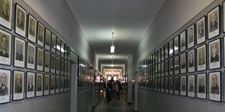 The prisoner blocks that once held thousands of inmates, now house thousands of exhibits instead, the only tangible evidence of the lives that were lost. This hallway displays portraits of camp inmates, men photographed in their striped uniforms during registration, faces from a different time, staring out into ours. After 1943, the photographs were superseded by camp numbers tattooed on prisoners' left forearms. None of the prisoners in these photographs survived. The prisoner blocks that once held thousands of inmates, now house thousands of exhibits instead, the only tangible evidence of the lives that were lost. This hallway displays portraits of camp inmates, men photographed in their striped uniforms during registration, faces from a different time, staring out into ours. After 1943, the photographs were superseded by camp numbers tattooed on prisoners' left forearms. None of the prisoners in these photographs survived.
 The displays of material objects, once possessions of the victims, are probably the most disturbing of all the exhibits at Auschwitz. Pictured here is one of the less innocuous displays, the mangled pile of eyeglasses. Other displays, such as the piles and piles of human hair, seemed to me too personal and too horrific to photograph. The displays of material objects, once possessions of the victims, are probably the most disturbing of all the exhibits at Auschwitz. Pictured here is one of the less innocuous displays, the mangled pile of eyeglasses. Other displays, such as the piles and piles of human hair, seemed to me too personal and too horrific to photograph.
 Between Blocks 10 and 11 is the courtyard of the Death Wall, also called the Black Wall. It was here that the SS shot several thousand prisoners between 1941 and 1943. The courtyard is enclosed on two sides by a high wall. Wooden blinds on the windows facing the courtyard prevented observation of the executions. I had to wait a very long time before I could get this picture, as other visitors were taking photographs of each other in front of the wall. I found this to be a troubling practice by many of the museum guests. I began to understand why some survivors have disapproved of the efforts for memorialization at Auschwitz due to the distasteful "touristy" feeling that has emerged. Between Blocks 10 and 11 is the courtyard of the Death Wall, also called the Black Wall. It was here that the SS shot several thousand prisoners between 1941 and 1943. The courtyard is enclosed on two sides by a high wall. Wooden blinds on the windows facing the courtyard prevented observation of the executions. I had to wait a very long time before I could get this picture, as other visitors were taking photographs of each other in front of the wall. I found this to be a troubling practice by many of the museum guests. I began to understand why some survivors have disapproved of the efforts for memorialization at Auschwitz due to the distasteful "touristy" feeling that has emerged.
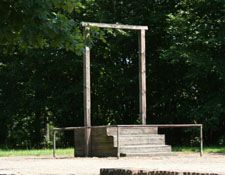 This gallows at Auschwitz, in front of the entrance to the gas chamber where the building of the camp Gestapo once stood, was built on April 16, 1947, to hang the first commandant of Auschwitz, Rudolf Höss. Responsible for exterminating 2.5 million people in WWII, he was a mild-mannered, happily married Catholic who enjoyed "normal" family life with his wife and five children despite his view of the crematoria chimney stacks from his bedroom window. At peak efficiency, Auschwitz had the capacity to "get rid of ten thousand people in 24 hours," as Rudolf Höss would testify during the War Crimes Trials after WWII. Witness after witness, document after document produced irrefutable evidence of the crimes committed, but no witness was more shocking than Rudolf Höss, who calmly explained how he had come to exterminate 2.5 million people. This gallows at Auschwitz, in front of the entrance to the gas chamber where the building of the camp Gestapo once stood, was built on April 16, 1947, to hang the first commandant of Auschwitz, Rudolf Höss. Responsible for exterminating 2.5 million people in WWII, he was a mild-mannered, happily married Catholic who enjoyed "normal" family life with his wife and five children despite his view of the crematoria chimney stacks from his bedroom window. At peak efficiency, Auschwitz had the capacity to "get rid of ten thousand people in 24 hours," as Rudolf Höss would testify during the War Crimes Trials after WWII. Witness after witness, document after document produced irrefutable evidence of the crimes committed, but no witness was more shocking than Rudolf Höss, who calmly explained how he had come to exterminate 2.5 million people.
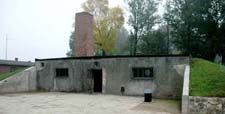 The first crematorium of Auschwitz, Crematorium I, is situated just outside the main fence of the camp. Both the gas chamber and the furnaces are contained in this one-time ammunitions bunker, which operated from August 1940 until July 1943. Crematorium I was first used to burn the bodies of victims who had died from torture, starvation, execution, exhaustion, or any other number of ways that inmates died. The first operations for the mass murder of Jews was not carried out here until early 1942, when the morgue of Crematorium I had been converted into a gas chamber. After the opening of the larger facility at Birkenau, exterminations at this site gradually ended. The first crematorium of Auschwitz, Crematorium I, is situated just outside the main fence of the camp. Both the gas chamber and the furnaces are contained in this one-time ammunitions bunker, which operated from August 1940 until July 1943. Crematorium I was first used to burn the bodies of victims who had died from torture, starvation, execution, exhaustion, or any other number of ways that inmates died. The first operations for the mass murder of Jews was not carried out here until early 1942, when the morgue of Crematorium I had been converted into a gas chamber. After the opening of the larger facility at Birkenau, exterminations at this site gradually ended.
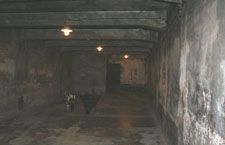 Jewish prisoners classified as unfit for labor were taken immediately to the gas chamber, lulled into thinking they were entering showers for bathing. After a few hundred victims were packed into this chamber, the doors were sealed and SS men on the roof, protected by gas masks, poured Zyklon-B crystals into the chamber through portals in the ceiling, inflicting an agonizing death on the hundreds of helpless within. Jewish prisoners classified as unfit for labor were taken immediately to the gas chamber, lulled into thinking they were entering showers for bathing. After a few hundred victims were packed into this chamber, the doors were sealed and SS men on the roof, protected by gas masks, poured Zyklon-B crystals into the chamber through portals in the ceiling, inflicting an agonizing death on the hundreds of helpless within.
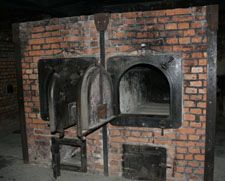 The bodies of the victims were dragged out of the chamber, their hair was cut and dental work and jewelry made of precious metals were removed before their bodies were incinerated in the brick ovens. When I was setting my camera for this shot, an older gentleman became highly agitated with me and the other guests who were all taking pictures of the furnaces. Not wanting to offend him further, I took no other pictures, as he was batting away the cameras. To him, our presence was a violation of the site and I understood his objection. I was conflicted over my role in being there, which I viewed as an educator hoping to use the materials and photographs I was collecting in the advancement of Holocaust memorialization theory and methods for future generations. However, my presence and actions were an affront to a generational member who had significant ties to the actual events that had transpired there. How does a public historian find a balance between the two? The bodies of the victims were dragged out of the chamber, their hair was cut and dental work and jewelry made of precious metals were removed before their bodies were incinerated in the brick ovens. When I was setting my camera for this shot, an older gentleman became highly agitated with me and the other guests who were all taking pictures of the furnaces. Not wanting to offend him further, I took no other pictures, as he was batting away the cameras. To him, our presence was a violation of the site and I understood his objection. I was conflicted over my role in being there, which I viewed as an educator hoping to use the materials and photographs I was collecting in the advancement of Holocaust memorialization theory and methods for future generations. However, my presence and actions were an affront to a generational member who had significant ties to the actual events that had transpired there. How does a public historian find a balance between the two?
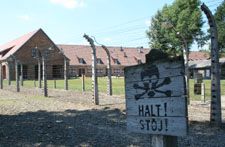 When I eventually exited the camp I felt frustration and disappointment with my visit. I had failed to make any kind of personal connection at Auschwitz, as I had at Majdanek and Belzec - that one moment when the enormity of the history of the site washed over me for one very brief moment. I have thought about this a great deal since my return home, and I think the answer lies in the words of my traveling research assistant and good friend, Michelle: "it was impossible to wrap our minds around it . . ." When I eventually exited the camp I felt frustration and disappointment with my visit. I had failed to make any kind of personal connection at Auschwitz, as I had at Majdanek and Belzec - that one moment when the enormity of the history of the site washed over me for one very brief moment. I have thought about this a great deal since my return home, and I think the answer lies in the words of my traveling research assistant and good friend, Michelle: "it was impossible to wrap our minds around it . . ."
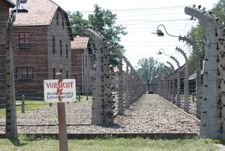 . . . I was an outsider, a visitor, I had hoped a witness, who spent 4 hours trying to achieve one brief passing moment wherein I comprehended the experiences of tortured and murdered victims of Nazi cruelty - but I could not. Perhaps the scripted, overly dramatized voice of our tour guide interfered with my own private contemplation, perhaps not - or maybe the "touristy" demeanor of some of the visitors distracted me - maybe not. Maybe the moment I seek is impossible for me as an outsider to experience - maybe not. But I will return to Auschwitz again, hopefully more than once, and I will continue trying to find my human connection to the world's greatest episode of complete inhumanity. . . . I was an outsider, a visitor, I had hoped a witness, who spent 4 hours trying to achieve one brief passing moment wherein I comprehended the experiences of tortured and murdered victims of Nazi cruelty - but I could not. Perhaps the scripted, overly dramatized voice of our tour guide interfered with my own private contemplation, perhaps not - or maybe the "touristy" demeanor of some of the visitors distracted me - maybe not. Maybe the moment I seek is impossible for me as an outsider to experience - maybe not. But I will return to Auschwitz again, hopefully more than once, and I will continue trying to find my human connection to the world's greatest episode of complete inhumanity.
 After leaving Auschwitz I, we traveled down the road to Birkenau, the second phase of the Auschwitz camp system, and the site of the world's largest mass murder. The Birkenau "Gate of Death" through which the trains passed with their human cargo . . . After leaving Auschwitz I, we traveled down the road to Birkenau, the second phase of the Auschwitz camp system, and the site of the world's largest mass murder. The Birkenau "Gate of Death" through which the trains passed with their human cargo . . .
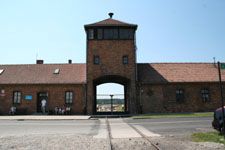 . . . appeared as a huge gaping mouth ready to devour its fodder. I had seen this sight in my studies over and over but nothing could have prepared me for the sensations of standing in its shadows and entering into the vastness of the site, sprawling over 425 square acres. It was not only the largest site within the Auschwitz complex, but it was also the largest camp in the entire Nazi camp system. . . . appeared as a huge gaping mouth ready to devour its fodder. I had seen this sight in my studies over and over but nothing could have prepared me for the sensations of standing in its shadows and entering into the vastness of the site, sprawling over 425 square acres. It was not only the largest site within the Auschwitz complex, but it was also the largest camp in the entire Nazi camp system.
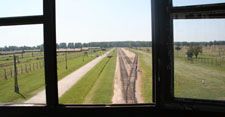 The camp was literally dissected by the train tracks and roadway that stretched out from the camp entrance all the way to the site of the crematoriums in the far distance. Over 300 single-story barracks housed the prisoners that were "selected" for labor rather than for extermination. The camp was literally dissected by the train tracks and roadway that stretched out from the camp entrance all the way to the site of the crematoriums in the far distance. Over 300 single-story barracks housed the prisoners that were "selected" for labor rather than for extermination.
 The Birkenau Camp was made up of several separate components with varying uses and histories. The Birkenau camp consisted of 3 "sectors," comprising 9 separate camps, each surrounded by barbed wire. There were separate camps for women and men of various nationalities, both Jewish and non-Jewish. There were family camps for Jews from the Theresienstadt Ghetto and for Gypsies, and transit camps for Jews from Hungary. There was a quarantine camp for newly arrived prisoners, and a camp where the sick were held and where most of the medical experiments were performed. A separate sector, known as "Kanada," was set aside for gathering and sorting the plundered property of the victims. Nearly ten miles worth of fences and guard towers encompassed the camp and separated sectors. The Birkenau Camp was made up of several separate components with varying uses and histories. The Birkenau camp consisted of 3 "sectors," comprising 9 separate camps, each surrounded by barbed wire. There were separate camps for women and men of various nationalities, both Jewish and non-Jewish. There were family camps for Jews from the Theresienstadt Ghetto and for Gypsies, and transit camps for Jews from Hungary. There was a quarantine camp for newly arrived prisoners, and a camp where the sick were held and where most of the medical experiments were performed. A separate sector, known as "Kanada," was set aside for gathering and sorting the plundered property of the victims. Nearly ten miles worth of fences and guard towers encompassed the camp and separated sectors.
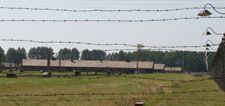 The oldest part of the Birkenau camp was located in sector BI, left of the entrance. At first, the only buildings here were brick barracks, constructed of materials pillaged from the local farmsteads whose Polish owners had been evicted. When the Nazis ran out of bricks, wooden barracks fashioned after horses stables were used later. Chimney flues were added inside that gave little heat in the freezing winters. The oldest part of the Birkenau camp was located in sector BI, left of the entrance. At first, the only buildings here were brick barracks, constructed of materials pillaged from the local farmsteads whose Polish owners had been evicted. When the Nazis ran out of bricks, wooden barracks fashioned after horses stables were used later. Chimney flues were added inside that gave little heat in the freezing winters.
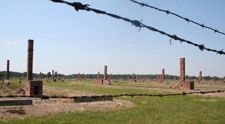 Sector B II, to the right of the entrance, was divided into 6 separate parts, each being its own autonomous camp. Here the field of chimneys shows the outlines of foundations and hearths that are what remain from the majority of the wooden barracks. It was incomprehensible that this field of smoke stacks seemed to go on as far as the eye could see. Sector B II, to the right of the entrance, was divided into 6 separate parts, each being its own autonomous camp. Here the field of chimneys shows the outlines of foundations and hearths that are what remain from the majority of the wooden barracks. It was incomprehensible that this field of smoke stacks seemed to go on as far as the eye could see.
 This first row of preserved wooden barracks in Sector B II numbers about 20 barracks deep and served as the quarantine area for new male prisoners. Here "quarantine" was used to intimidate newly arrived prisoners and break them into the camp's strict rules and unquestioning obedience. Within these barracks are preserved bunks, latrines, and heating stoves. This first row of preserved wooden barracks in Sector B II numbers about 20 barracks deep and served as the quarantine area for new male prisoners. Here "quarantine" was used to intimidate newly arrived prisoners and break them into the camp's strict rules and unquestioning obedience. Within these barracks are preserved bunks, latrines, and heating stoves.
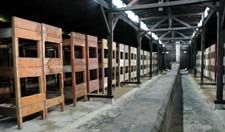 Here is seen the interior of the wooden barracks at Birkenau with the wooden bunks, which were over crowded with hundreds of prisoners. An average of five people shared each bunk. The brick barracks were built without foundations, directly on swampy ground, which could turned into a quagmire in the winter. The brick barracks housed women prisoners who slept on three tiered berths spread over with rotting straw. On one level an average of 8 people would lie. Here is seen the interior of the wooden barracks at Birkenau with the wooden bunks, which were over crowded with hundreds of prisoners. An average of five people shared each bunk. The brick barracks were built without foundations, directly on swampy ground, which could turned into a quagmire in the winter. The brick barracks housed women prisoners who slept on three tiered berths spread over with rotting straw. On one level an average of 8 people would lie.
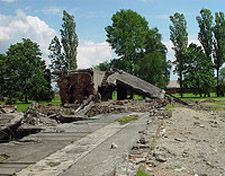 Museum curators had decided long ago to leave the demolished remains of the crematoria at Birkenau as camp ruins, rather than trying to reconstruct the buildings. This photograph is of Crematorium II, where we can plainly see the floor of the furnace room and traces of the tracks used to carry bodies to the furnaces. Crematorium II had 15 furnaces, built in 5 sets of 3 ovens apiece. Ruins exist for Crematoriums III, IV, and V as well. It certainly was a factory of death. Museum curators had decided long ago to leave the demolished remains of the crematoria at Birkenau as camp ruins, rather than trying to reconstruct the buildings. This photograph is of Crematorium II, where we can plainly see the floor of the furnace room and traces of the tracks used to carry bodies to the furnaces. Crematorium II had 15 furnaces, built in 5 sets of 3 ovens apiece. Ruins exist for Crematoriums III, IV, and V as well. It certainly was a factory of death.
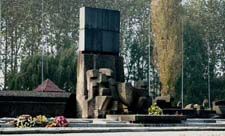 An International Memorial to the victims of the Auschwitz Camp Complex was erected in 1967. Earlier, a different memorial stood here that opened in 1947 - the second memorial site of its kind in post-war Europe, after Majdanek. Since its inception, the Auschwitz Birkenau Memorial and Museum have hosted over 30 million visitors from all over the world.(these 3 photo credits scrapbookpages.com) Without a doubt, Auschwitz remains the single greatest memory tool for the preservation of Holocaust history. Without any other form of interpretation, not by guides, nor historians, nor even by survivors themselves, one needs only to view the sites, see the pictures, and dwell over the relics to witness for themselves the atrocity that was Auschwitz. An International Memorial to the victims of the Auschwitz Camp Complex was erected in 1967. Earlier, a different memorial stood here that opened in 1947 - the second memorial site of its kind in post-war Europe, after Majdanek. Since its inception, the Auschwitz Birkenau Memorial and Museum have hosted over 30 million visitors from all over the world.(these 3 photo credits scrapbookpages.com) Without a doubt, Auschwitz remains the single greatest memory tool for the preservation of Holocaust history. Without any other form of interpretation, not by guides, nor historians, nor even by survivors themselves, one needs only to view the sites, see the pictures, and dwell over the relics to witness for themselves the atrocity that was Auschwitz.
Return to top of page

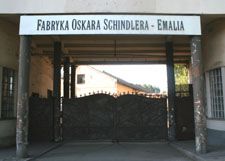 Oskar Schindler's enamel factory has become one of Krakow's most popular tourist sites, thanks to the Steven Spielberg blockbuster movie, named after the German munitions manufacturer. A plaque on the site reads in broken English: "The Workplace over 1000 Jewish Nationality Persons. During Second World War - Saved their life by Oskar Schindler." It seemed appropriate to visit the site, since we had visited his grave months earlier in Jerusalem. Oskar Schindler's enamel factory has become one of Krakow's most popular tourist sites, thanks to the Steven Spielberg blockbuster movie, named after the German munitions manufacturer. A plaque on the site reads in broken English: "The Workplace over 1000 Jewish Nationality Persons. During Second World War - Saved their life by Oskar Schindler." It seemed appropriate to visit the site, since we had visited his grave months earlier in Jerusalem.
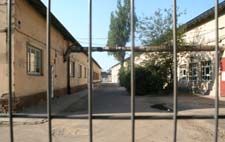 This picture is looking into the area of the living barracks for the Jewish workers of the "Deutsche Emalienwaren Fabrik," the Schindler Factory at Lipowa - Szeroka. The factory is an ordinary gray stucco three-story building with lots of windows, built right next to the sidewalk. The architectural style of the building is what Americans would call Art Deco; in Poland in the 1940s, this style was called Modern. This picture is looking into the area of the living barracks for the Jewish workers of the "Deutsche Emalienwaren Fabrik," the Schindler Factory at Lipowa - Szeroka. The factory is an ordinary gray stucco three-story building with lots of windows, built right next to the sidewalk. The architectural style of the building is what Americans would call Art Deco; in Poland in the 1940s, this style was called Modern.
 Schindler's real office, pictured here, was not used in Spielberg's Schindler's List. As a historian, I couldn't help but cringe at the "Hollywood version" being promoted at this site and others that are booked as a tour of the movie sites for Schindler's List. It seemed that Spielberg's use or non-use of the sites was more important than the actual historical significance of the sites themselves. Schindler's real office, pictured here, was not used in Spielberg's Schindler's List. As a historian, I couldn't help but cringe at the "Hollywood version" being promoted at this site and others that are booked as a tour of the movie sites for Schindler's List. It seemed that Spielberg's use or non-use of the sites was more important than the actual historical significance of the sites themselves.

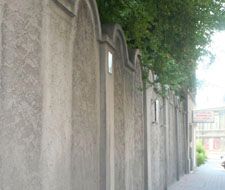 The Podgorze Ghetto in Krakow was established over a 2 year period from March 1941 to March 1943, interning about 20,000 Jews. The Ghetto was liquidated in 3 separate actions. Pictured here is a portion of the Ghetto Wall, restored as a memorial to the victims of the Ghetto, who were forced by their jailers to build their own wall. Doors and windows of the buildings on the outer boundary of the Ghetto were also sealed shut. After the Jews were deported to other camps and extermination sites, most of the walls and fences of the Ghetto were destroyed by the returning Polish citizens, seeking to reclaim parts of the city. The Podgorze Ghetto in Krakow was established over a 2 year period from March 1941 to March 1943, interning about 20,000 Jews. The Ghetto was liquidated in 3 separate actions. Pictured here is a portion of the Ghetto Wall, restored as a memorial to the victims of the Ghetto, who were forced by their jailers to build their own wall. Doors and windows of the buildings on the outer boundary of the Ghetto were also sealed shut. After the Jews were deported to other camps and extermination sites, most of the walls and fences of the Ghetto were destroyed by the returning Polish citizens, seeking to reclaim parts of the city.
 The ghetto scenes in Schindler's List depict the Krakow Ghetto, but were not filmed in the modern city. Only a few buildings and the one small section of the wall seen above still remain from the Podgorze Ghetto. A plaque adjoining this one inscribed in English reads: The ghetto scenes in Schindler's List depict the Krakow Ghetto, but were not filmed in the modern city. Only a few buildings and the one small section of the wall seen above still remain from the Podgorze Ghetto. A plaque adjoining this one inscribed in English reads:
"Here stand the remnants of the walls of the Krakow Ghetto that existed from 1941 till 1943. These walls have been restored in memory of the Jews of Krakow by the Moseberg Family Foundation."
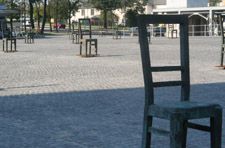 The Memorial seen here was opened on December 8, 2005 in the Ghetto Heroes Square of the Podgorze Ghetto. The design includes 33 large empty chairs and 37 smaller chairs located on the edge of the square and at the tram stops. The Memorial also includes a mark on the pavement which shows where the walls of the Ghetto were formerly located and a small building where visitors may light candles in honor of the murdered Jews. This square was called the Umschlagplatz by the Nazis; it was the place where the Jews had to assemble before being transported to the Belzec Death Camp in two separate actions in June 1942 and October 1942. The Podgorze Ghetto was liquidated on March 13, 1943 when the Jews who were able to work were sent to the Plaszow forced labor camp just outside the city of Krakow, and the rest were sent to the death camp at Auschwitz II Birkenau. March 13, 1943 was the day that the gas chamber in Krema II at Birkenau was first used when 1,492 women, children and elderly Jews from the Podgorze Ghetto were put to death immediately upon arrival and their bodies were burned in the ovens. The Memorial seen here was opened on December 8, 2005 in the Ghetto Heroes Square of the Podgorze Ghetto. The design includes 33 large empty chairs and 37 smaller chairs located on the edge of the square and at the tram stops. The Memorial also includes a mark on the pavement which shows where the walls of the Ghetto were formerly located and a small building where visitors may light candles in honor of the murdered Jews. This square was called the Umschlagplatz by the Nazis; it was the place where the Jews had to assemble before being transported to the Belzec Death Camp in two separate actions in June 1942 and October 1942. The Podgorze Ghetto was liquidated on March 13, 1943 when the Jews who were able to work were sent to the Plaszow forced labor camp just outside the city of Krakow, and the rest were sent to the death camp at Auschwitz II Birkenau. March 13, 1943 was the day that the gas chamber in Krema II at Birkenau was first used when 1,492 women, children and elderly Jews from the Podgorze Ghetto were put to death immediately upon arrival and their bodies were burned in the ovens.

 Kazimierz was founded as a separate town by King Casimir the Great in 1335. In the late 15th century Jews from Krakow were moved there, establishing a separate Jewish town with their houses, businesses, synagogues and cemeteries. The character of this city, later a district of Krakow, changed drastically during WWII. As a consequence of the Holocaust, two-thirds of the residents of Kazimierz died either in the Podgorze Ghetto or in the extermination camps. Only 6,000 Polish Jews came back to live there but many of them subsequently emigrated to the USA or Israel. Kazimierz was founded as a separate town by King Casimir the Great in 1335. In the late 15th century Jews from Krakow were moved there, establishing a separate Jewish town with their houses, businesses, synagogues and cemeteries. The character of this city, later a district of Krakow, changed drastically during WWII. As a consequence of the Holocaust, two-thirds of the residents of Kazimierz died either in the Podgorze Ghetto or in the extermination camps. Only 6,000 Polish Jews came back to live there but many of them subsequently emigrated to the USA or Israel.
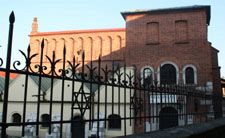 Krakow’s Kazimierz District preserves a unique atmosphere of the Jewish past of this area. The exhibits of the Museum of Judaism at 24 Szeroka Street are housed in the stately brick building of the Old Synagogue, which dates back to the 15th century and was rebuilt to Renaissance tastes in the 1560s. Krakow’s Kazimierz District preserves a unique atmosphere of the Jewish past of this area. The exhibits of the Museum of Judaism at 24 Szeroka Street are housed in the stately brick building of the Old Synagogue, which dates back to the 15th century and was rebuilt to Renaissance tastes in the 1560s.
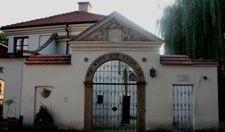 Kazimierz's Old Jewish Cemetery adjoins the Remuh Synagogue on Szeroka St., which was named after the famous 16th-century Rabbi and religious writer Moses Isserles. The cemetery was used from 1551 to 1800. Its hundreds old tombstones, dating mostly from the Renaissance, as well as its history and surroundings make the Remuh Cemetery an important legacy of Jewish culture. Kazimierz's Old Jewish Cemetery adjoins the Remuh Synagogue on Szeroka St., which was named after the famous 16th-century Rabbi and religious writer Moses Isserles. The cemetery was used from 1551 to 1800. Its hundreds old tombstones, dating mostly from the Renaissance, as well as its history and surroundings make the Remuh Cemetery an important legacy of Jewish culture.
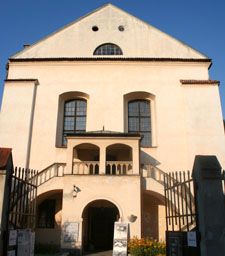 All of Krakow’s seven synagogues are situated in the former Jewish quarter of the town of Kazimierz. The Isaac Synagogue, founded by a wealthy local banker, Isaac reb Yekele, dates back to 1644. It had undergone a major refurbishment in 1857 and was completely damaged by the Nazis during the German occupation of Krakow. The synagogue has been reconstructed in the 1970s and the 1980s. The Kazimierz district has become newly fashionable in the recent decade. With its mushrooming cafes and nightlife spots, it has become Krakow’s equivalent of London’s Soho, Paris’ Quartier Latin, and New York’s Village. Kazimierz District's recreated Jewish past has given it a newborn reputation as a haven for artists and as a new "trendy" tourist spot as well. All of Krakow’s seven synagogues are situated in the former Jewish quarter of the town of Kazimierz. The Isaac Synagogue, founded by a wealthy local banker, Isaac reb Yekele, dates back to 1644. It had undergone a major refurbishment in 1857 and was completely damaged by the Nazis during the German occupation of Krakow. The synagogue has been reconstructed in the 1970s and the 1980s. The Kazimierz district has become newly fashionable in the recent decade. With its mushrooming cafes and nightlife spots, it has become Krakow’s equivalent of London’s Soho, Paris’ Quartier Latin, and New York’s Village. Kazimierz District's recreated Jewish past has given it a newborn reputation as a haven for artists and as a new "trendy" tourist spot as well.

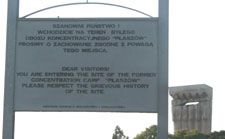 The Plaszow Concentration Camp was established in December 1942 on the territory of the Jewish cemetery. It was the last camp established in Poland, and 150,000 victims passed through it in all. Of this number, more than half - 80,000 - lost their lives before the camp was liquidated in the fall of 1944. The sign at its entrance reads: "Dear Visitors - You are entering the site of the former concentration camp 'Plaszow'. Please respect the grievous history of the site." Aside from the massive memorial, there is not much there to respect. The Plaszow Concentration Camp was established in December 1942 on the territory of the Jewish cemetery. It was the last camp established in Poland, and 150,000 victims passed through it in all. Of this number, more than half - 80,000 - lost their lives before the camp was liquidated in the fall of 1944. The sign at its entrance reads: "Dear Visitors - You are entering the site of the former concentration camp 'Plaszow'. Please respect the grievous history of the site." Aside from the massive memorial, there is not much there to respect.
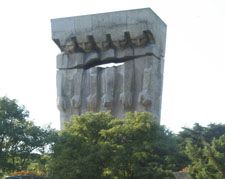 The Plaszow Camp Memorial is a gigantic stone sculpture that displays 6 sharply etched figures with heads bowed in mourning, cut front to back, edge to edge by a great horizontal gash at about lapel level. The figures are angular and somewhat abstract. The feeling it evokes is one of smallness as the monolithic figures, representing the 6 million Jewish victims of the Holocaust, stare down at you, with what appears to be a schism through the heart of the entire piece. The Plaszow Camp Memorial is a gigantic stone sculpture that displays 6 sharply etched figures with heads bowed in mourning, cut front to back, edge to edge by a great horizontal gash at about lapel level. The figures are angular and somewhat abstract. The feeling it evokes is one of smallness as the monolithic figures, representing the 6 million Jewish victims of the Holocaust, stare down at you, with what appears to be a schism through the heart of the entire piece.
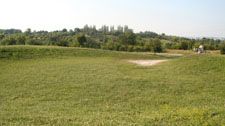 Absolutely nothing remains of the camp, which was depicted in Spielberg's movie "Schindler's List." The site now holds the mammoth memorial seen above and other smaller memorial monuments and then just fields of gently rolling vacant hills. Of all the sites of past concentration camps I have seen, this one is the most understated and neglected. Absolutely nothing remains of the camp, which was depicted in Spielberg's movie "Schindler's List." The site now holds the mammoth memorial seen above and other smaller memorial monuments and then just fields of gently rolling vacant hills. Of all the sites of past concentration camps I have seen, this one is the most understated and neglected.
Return to top of page.

Prague is the capital of the Czech Republic and ancient Bohemia. Before the Holocaust and for many centuries, it was one of the most important Jewish centers in Europe. History reveals that Jews have lived in Prague since 970 C.E. and by the end of the 11th Century, a Jewish community had been fully established. On March 14, 1939, Slovakia declared independence from Prague and signed the Treaty of Protection with Nazi Germany. The next day, Germany occupied Czech lands. At the outbreak of WW II, 55,000 Jews lived in Prague, almost 20 percent of the city’s population. At least two-thirds of the Jewish population of Prague perished in the Holocaust.

The largest and most complete collection of Judaicum can be found at the Jewish Museum in the Jewish district of Prague. It houses a collection of approximately 40,000 artistic artifacts and 100,000 items of printed material. Synagogue objects, mainly textiles and silver, comprise almost two-thirds of the collection. The rest of the collection consists of household ritual items, paintings, drawings, prints, manuscripts and photographs, as well as artifacts from the Theresienstadt Ghetto, including a unique collection of children's drawings.
 Founded in 1906, the Jewish Museum preserved artifacts from the synagogues of Prague that were being liquidated at the turn of the century. The museum was closed to the public after Nazi occupation in 1939. The Nazis decided not to destroy the museum, but instead used it as a "Museum of an Extinct Race." The Germans hired Dr. Stein, historian and founder of the museum, to catalogue tens of thousands of confiscated items from more than 153 destroyed Jewish communities throughout Bohemia and Moravia, to bear witness of the Nazi decimation of World Jewry. Following World War II, the Museum was administered by the Council of Jewish Communities in Czechoslovakia. In 1950, ownership was transferred to the state. After the collapse of communism in 1989, the museum’s status changed again. It is now an independent body governed by a council composed of two representatives of the Community, two representatives of the Federation of Jewish Communities, and one representative from the Ministry of Culture. Founded in 1906, the Jewish Museum preserved artifacts from the synagogues of Prague that were being liquidated at the turn of the century. The museum was closed to the public after Nazi occupation in 1939. The Nazis decided not to destroy the museum, but instead used it as a "Museum of an Extinct Race." The Germans hired Dr. Stein, historian and founder of the museum, to catalogue tens of thousands of confiscated items from more than 153 destroyed Jewish communities throughout Bohemia and Moravia, to bear witness of the Nazi decimation of World Jewry. Following World War II, the Museum was administered by the Council of Jewish Communities in Czechoslovakia. In 1950, ownership was transferred to the state. After the collapse of communism in 1989, the museum’s status changed again. It is now an independent body governed by a council composed of two representatives of the Community, two representatives of the Federation of Jewish Communities, and one representative from the Ministry of Culture.
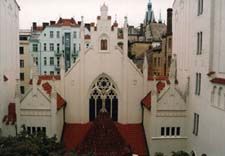 Besides the main building, the Jewish Museum rents the Old Jewish Cemetery, the Pinkas Synagogue, the Ceremonial Hall, the Klausen Synagogue, the Maisel Synagogue and the Spanish Synagogue from the Jewish Community to display items belonging to the Museum. The Maisel Synagogue was originally built in 1591, thanks to a special permit given by Emperor Rudolph II. The synagogue is named after Mordechai Maisel, whose money was used to build it. Besides the main building, the Jewish Museum rents the Old Jewish Cemetery, the Pinkas Synagogue, the Ceremonial Hall, the Klausen Synagogue, the Maisel Synagogue and the Spanish Synagogue from the Jewish Community to display items belonging to the Museum. The Maisel Synagogue was originally built in 1591, thanks to a special permit given by Emperor Rudolph II. The synagogue is named after Mordechai Maisel, whose money was used to build it.
 The synagogue had been damaged in several fires and its current facade is due to reconstruction in 1862 - 1864. In the 19th Century, the synagogue was the birthplace of liberal Judaism. During the Holocaust it housed more than 15,000 Jewish objects and art. Today it functions as the primary repository of religious objects for the Jewish Museum. It is tragically ironic that although Hitler could not take pride in his assemblage of Jewish artifacts as evidence of his annihilation of their "race," here they were all displayed by the Czech's instead, as evidence of a culturally rich Jewish past from communities that indeed no longer existed. The synagogue had been damaged in several fires and its current facade is due to reconstruction in 1862 - 1864. In the 19th Century, the synagogue was the birthplace of liberal Judaism. During the Holocaust it housed more than 15,000 Jewish objects and art. Today it functions as the primary repository of religious objects for the Jewish Museum. It is tragically ironic that although Hitler could not take pride in his assemblage of Jewish artifacts as evidence of his annihilation of their "race," here they were all displayed by the Czech's instead, as evidence of a culturally rich Jewish past from communities that indeed no longer existed.
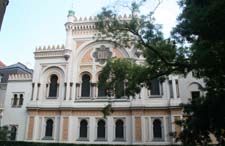 The Spanish Synagogue was built in 1867-1868, using Moorish decorations. It was built on the site of the oldest Prague Jewish house of prayer ("the Old Shul"). The Spanish Synagogue is the second part of the permanent exhibition “History of the Jews in Bohemia and Moravia - from Emancipation to the Present.” The upper floor prayer hall exhibits Synagogue Silver from Bohemia and Moravia. The Spanish Synagogue was built in 1867-1868, using Moorish decorations. It was built on the site of the oldest Prague Jewish house of prayer ("the Old Shul"). The Spanish Synagogue is the second part of the permanent exhibition “History of the Jews in Bohemia and Moravia - from Emancipation to the Present.” The upper floor prayer hall exhibits Synagogue Silver from Bohemia and Moravia.
 The Spanish Synagogue provides an interesting contrast to the other synagogues in Prague because its interior is filled with Moorish and Islamic designs and art. During the Holocaust it was used to store Torah curtains. Today it also houses the headquarters for the entire Jewish Museum system. After being closed for over 20 years, the Spanish Synagogue was reopened on the 130th anniversary of its establishment. This completed the most ambitious projects of the Jewish Museum in Prague to date. The Spanish Synagogue provides an interesting contrast to the other synagogues in Prague because its interior is filled with Moorish and Islamic designs and art. During the Holocaust it was used to store Torah curtains. Today it also houses the headquarters for the entire Jewish Museum system. After being closed for over 20 years, the Spanish Synagogue was reopened on the 130th anniversary of its establishment. This completed the most ambitious projects of the Jewish Museum in Prague to date.
 The Pinkas Synagogue, built in a Renaissance style, was first mentioned in 1492. Located in a flood zone, it was frequently being repaired and reconstruction occurred in 1953. Following World War II it became a memorial to Moravian and Bohemian Jews who perished in the war. The Pinkas Synagogue, built in a Renaissance style, was first mentioned in 1492. Located in a flood zone, it was frequently being repaired and reconstruction occurred in 1953. Following World War II it became a memorial to Moravian and Bohemian Jews who perished in the war.
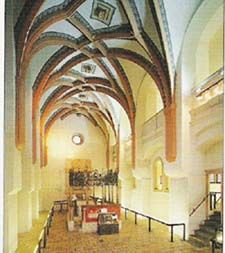 On the walls of the synagogue, there is a list of 77,297 names of those who died. Following the communist occupation in August 1968, all of the names were erased, but these areas have since been restored. The synagogue was closed from 1968 until 1992 because of the penetration of underground water. Today visitors can once again see the over 77 thousand names of Jews murdered in the Holocaust as well as a display of Jewish pictures and drawings on the upper level. This was perhaps one of the most beautiful forms of memorialization to Holocaust victims I have ever seen, As we walked in and out of the areas of the Synagogue, beautiful calligraphic names accompanied us throughout. On the walls of the synagogue, there is a list of 77,297 names of those who died. Following the communist occupation in August 1968, all of the names were erased, but these areas have since been restored. The synagogue was closed from 1968 until 1992 because of the penetration of underground water. Today visitors can once again see the over 77 thousand names of Jews murdered in the Holocaust as well as a display of Jewish pictures and drawings on the upper level. This was perhaps one of the most beautiful forms of memorialization to Holocaust victims I have ever seen, As we walked in and out of the areas of the Synagogue, beautiful calligraphic names accompanied us throughout.
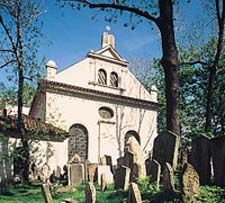 The Klausen Synagogue is located adjacent to the entrance to the Old Jewish Cemetery. It was built on land acquired by the late Mordechai Maisel. The synagogue, built in an early baroque style, was completed in 1694. It was remodeled a couple of times and the last adaptation took place in 1883-1834. During the Holocaust, imagery of the Jewish festivals and life cycle events were displayed. Recently the synagogue was restored to display exhibitions of old Hebrew manuscripts and prints for the Jewish Museum. The Klausen Synagogue is located adjacent to the entrance to the Old Jewish Cemetery. It was built on land acquired by the late Mordechai Maisel. The synagogue, built in an early baroque style, was completed in 1694. It was remodeled a couple of times and the last adaptation took place in 1883-1834. During the Holocaust, imagery of the Jewish festivals and life cycle events were displayed. Recently the synagogue was restored to display exhibitions of old Hebrew manuscripts and prints for the Jewish Museum.
 The Chevra Chadisha building (Burial Brotherhood Society of Prague), situated at the entrance of the Jewish Cemetery, was built in the early 1900's. The responsibility of the society was to watch over and take care of the dead body in the hours before it was going to be buried. Today this building is part of the Jewish Museum and contains a unique collection of children’s drawings and poems from the Theresienstadt Ghetto. The Chevra Chadisha building (Burial Brotherhood Society of Prague), situated at the entrance of the Jewish Cemetery, was built in the early 1900's. The responsibility of the society was to watch over and take care of the dead body in the hours before it was going to be buried. Today this building is part of the Jewish Museum and contains a unique collection of children’s drawings and poems from the Theresienstadt Ghetto.
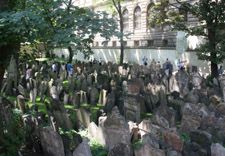 It is the Oldest Jewish Cemetery in Europe, opened from the 15th Century to the late 18th Century. In 1439, Avigdor Kara was the first person to be buried there. Over the next 400 years, about 200,000 residents of the Ghetto in Prague were buried in its confines. Since the cemetery could only hold about 10 percent of that amount, the tombs are layered on top of each other, at one section reaching 12 layers. Two of the cemetery’s most famous tombs are Rabbi Loew (1609) and Mordechai Maisel (1601). Since 1990, the Jewish Museum of Prague has been conserving and restoring the cemetery. Today, about 12,000 tombstones remain. It is the Oldest Jewish Cemetery in Europe, opened from the 15th Century to the late 18th Century. In 1439, Avigdor Kara was the first person to be buried there. Over the next 400 years, about 200,000 residents of the Ghetto in Prague were buried in its confines. Since the cemetery could only hold about 10 percent of that amount, the tombs are layered on top of each other, at one section reaching 12 layers. Two of the cemetery’s most famous tombs are Rabbi Loew (1609) and Mordechai Maisel (1601). Since 1990, the Jewish Museum of Prague has been conserving and restoring the cemetery. Today, about 12,000 tombstones remain.
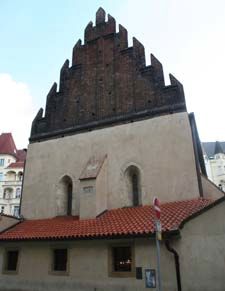 Staranova Synagogue is also known as Altneuschul (the Old-New Synagogue). It was originally built in 1270 and was called the New Synagogue because it was the second synagogue built in the Jewish quarter; the first synagogue no longer exists. The original floor still exists, however, other parts of the building have been rebuilt because of damage from flooding in the Jewish quarter. It is the oldest synagogue in Europe. During the Nazi occupation it showcased Jewish art, religious objects and books. Today services are still being conducted there, continuing a tradition of nearly 700 years, only interrupted between 1941 and 1945, the tragic years of WWII. Staranova Synagogue is also known as Altneuschul (the Old-New Synagogue). It was originally built in 1270 and was called the New Synagogue because it was the second synagogue built in the Jewish quarter; the first synagogue no longer exists. The original floor still exists, however, other parts of the building have been rebuilt because of damage from flooding in the Jewish quarter. It is the oldest synagogue in Europe. During the Nazi occupation it showcased Jewish art, religious objects and books. Today services are still being conducted there, continuing a tradition of nearly 700 years, only interrupted between 1941 and 1945, the tragic years of WWII.
 The High Synagogue, located adjacent to the Jewish Town Hall, is on the second floor of a building, not ground level. Originally it was only accessible from the first floor of the Jewish town hall. Today the High Synagogue is accessible from both the first floor of the Jewish Town Hall and from the Cervana Ulicka. Under the Communist reign all synagogues including the High Synagogue belonged to the State Jewish Museum. Today, the synagogue belongs to the Jewish community and is not part of the Jewish Museum. The High Synagogue, located adjacent to the Jewish Town Hall, is on the second floor of a building, not ground level. Originally it was only accessible from the first floor of the Jewish town hall. Today the High Synagogue is accessible from both the first floor of the Jewish Town Hall and from the Cervana Ulicka. Under the Communist reign all synagogues including the High Synagogue belonged to the State Jewish Museum. Today, the synagogue belongs to the Jewish community and is not part of the Jewish Museum.
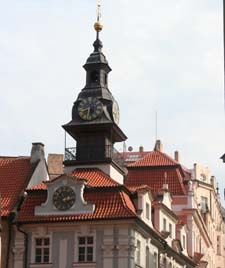 Prague is filled with many Jewish historical sites that give testament to its rich past as one of the centers of Jewish life. Many of these can be found in Josefov, site of the Jewish ghetto and village. A popular tourist site, the Hebrew and Roman faced clocks, (the clock with the Hebrew letters turns counterclockwise) is found here on the Jewish Town Hall. The Jewish Town Hall was built in the 16th Century by the Jewish mayor of Josefov. Today, it serves as the center of the Jewish community in Prague and houses the offices of the Federation of Jewish Communities in the Czech Lands.The Jewish Town Hall remains the center of Jewish life in Prague, housing Jewish cultural, social and religious events. Prague is filled with many Jewish historical sites that give testament to its rich past as one of the centers of Jewish life. Many of these can be found in Josefov, site of the Jewish ghetto and village. A popular tourist site, the Hebrew and Roman faced clocks, (the clock with the Hebrew letters turns counterclockwise) is found here on the Jewish Town Hall. The Jewish Town Hall was built in the 16th Century by the Jewish mayor of Josefov. Today, it serves as the center of the Jewish community in Prague and houses the offices of the Federation of Jewish Communities in the Czech Lands.The Jewish Town Hall remains the center of Jewish life in Prague, housing Jewish cultural, social and religious events.
In the Czech Republic, about 26,000 members of the Czech Jewish community escaped and emigrated to various countries and regions, including Palestine, the U.S., South America and Western Europe. Not all Czech Jews were so fortunate, 92,000 Jews remained in occupied Czech lands. Seventy-four thousand of the Czech Jews were imprisoned at Theresienstadt and 80 percent of those were deported to Auschwitz, Majdanek, Treblinka and Sobibor. Other Czech Jews were sent directly to death camps.
Today, only about 1,700 people are associated with the Jewish community in Prague. Many Jews found it easier to be quiet and hide their identity during the Communist era and so many people learned of being Jewish only after 1989. The average age in Prague’s Jewish community has dropped from 70 (the average age in the 1980's) to about 55 because of increased involvement of younger Jews.
Return to top of page

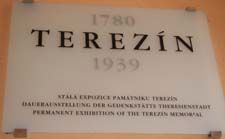 The foundation of the town of Terezin in the Czech Republic dates back to the late 18th century, when Emperor Josef II decided to build a fortress at the joining of the Elbe and Eger Rivers. Its mission was to prevent any future penetration by enemy forces in the Bohemia interior and to guard the Elbe waterway. The stronghold, built over a ten year period, consisted of the Main Fortress and the Small Fortress. The fortification enjoined a number of elements: massive bastions, ravelins, lunettes, bulwarks, flood moats, an extensive network of underground passages, and surrounding flood basins. The impregnable stronghold, however, was never used in battle and its fortifications gradually became obsolete. Finally the fortress was vacated and Terezin became a garrison town. The notorious 19th century penitentiary in the Small Fortress functioned well into the first half of the 20th century, serving as a military prison for a full 20 years after Czechoslovak independence in 1918. The foundation of the town of Terezin in the Czech Republic dates back to the late 18th century, when Emperor Josef II decided to build a fortress at the joining of the Elbe and Eger Rivers. Its mission was to prevent any future penetration by enemy forces in the Bohemia interior and to guard the Elbe waterway. The stronghold, built over a ten year period, consisted of the Main Fortress and the Small Fortress. The fortification enjoined a number of elements: massive bastions, ravelins, lunettes, bulwarks, flood moats, an extensive network of underground passages, and surrounding flood basins. The impregnable stronghold, however, was never used in battle and its fortifications gradually became obsolete. Finally the fortress was vacated and Terezin became a garrison town. The notorious 19th century penitentiary in the Small Fortress functioned well into the first half of the 20th century, serving as a military prison for a full 20 years after Czechoslovak independence in 1918.
 The town itself, the former Main Fortress, was turned into a ghetto and transit camp for Jews in November 1941 and renamed Theresienstadt by the Nazis. At first, Jews from Bohemia and Moravia were deported there, then later from other countries of the Third Reich. Prior to its formation, a Gestapo prison was opened at the Small Fortress of Terezin that functioned during the entire period of the war. Another labor camp was opened in nearby Litomerice in the Spring of 1944 to supply slave labor for the underground munitions factories. Over 200,000 people from 30 different countries were imprisoned in these three facilities between 1940 and 1945. Every 5th prisoner died in one of them and as many as 90,000 died after being deported to other places of internment or extermination. The town itself, the former Main Fortress, was turned into a ghetto and transit camp for Jews in November 1941 and renamed Theresienstadt by the Nazis. At first, Jews from Bohemia and Moravia were deported there, then later from other countries of the Third Reich. Prior to its formation, a Gestapo prison was opened at the Small Fortress of Terezin that functioned during the entire period of the war. Another labor camp was opened in nearby Litomerice in the Spring of 1944 to supply slave labor for the underground munitions factories. Over 200,000 people from 30 different countries were imprisoned in these three facilities between 1940 and 1945. Every 5th prisoner died in one of them and as many as 90,000 died after being deported to other places of internment or extermination.
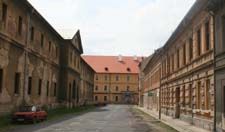 The Theresienstadt Ghetto was established on November 24, 1941. By 1942, all non-Jewish civilians had to leave and the entire town then became a large prison for Jewish victims from Moravia and Bohemia, elderly Jews, persons of 'special merit' in the Reich, and several thousand Jews from the Netherlands and Denmark. In total, more than 155,000 men, women and children went through the gates of the Theresienstadt Ghetto - about 35,000 of them died here and another 83,000 were deported out of Ghetto and died in other circumstances. The Theresienstadt Ghetto was established on November 24, 1941. By 1942, all non-Jewish civilians had to leave and the entire town then became a large prison for Jewish victims from Moravia and Bohemia, elderly Jews, persons of 'special merit' in the Reich, and several thousand Jews from the Netherlands and Denmark. In total, more than 155,000 men, women and children went through the gates of the Theresienstadt Ghetto - about 35,000 of them died here and another 83,000 were deported out of Ghetto and died in other circumstances.
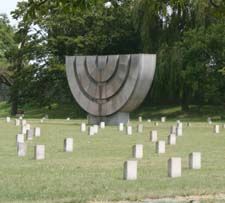 Whereas about 7,000 civilians and soldiers inhabited the fortress town of Terezin before the war, the Ghetto was the overcrowded home for as many as 58,500 Jewish prisoners at one time. One out of four died from the disastrous conditions in the Ghetto. Burials in mass graves at the Jewish cemetery occurred in the summer of 1942, when the death rate grew to catastrophic dimensions. A total of 9,000 people were buried in mass graves that are now marked by this commemorative Menorah in the Jewish cemetery. Whereas about 7,000 civilians and soldiers inhabited the fortress town of Terezin before the war, the Ghetto was the overcrowded home for as many as 58,500 Jewish prisoners at one time. One out of four died from the disastrous conditions in the Ghetto. Burials in mass graves at the Jewish cemetery occurred in the summer of 1942, when the death rate grew to catastrophic dimensions. A total of 9,000 people were buried in mass graves that are now marked by this commemorative Menorah in the Jewish cemetery.
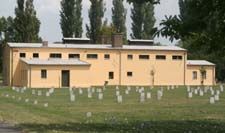 The ever-present hunger, epidemics of contagious diseases, terror and torture by SS guards, over work and over crowing kept the death rate high among the Ghetto prisoners. It resulted in the construction of a Terezin Crematorium in autumn of 1942 to dispose of the dead. Its furnaces consumed 30,000 victims from the Ghetto, the prison from the Small Fortress, and the camp at Litomerice. The ever-present hunger, epidemics of contagious diseases, terror and torture by SS guards, over work and over crowing kept the death rate high among the Ghetto prisoners. It resulted in the construction of a Terezin Crematorium in autumn of 1942 to dispose of the dead. Its furnaces consumed 30,000 victims from the Ghetto, the prison from the Small Fortress, and the camp at Litomerice.
 As part of the preparations for a visit by an international Red Cross delegation, Theresienstadt underwent a Beautification Action in 1943-1944 to obscure the reality of the "Final Solution of the Jewish Question" and to serve the propaganda machinery of Hitler's Germany. The overall appearance of the buildings and prisoner's dormitories was improved, and facilities were built that were not normally accessible to the priosners. Following the International Red Cross Committee delegation's visit, a propaganda film used the temporary accoutrements to portray Theresienstadt as an "autonomous Jewish settlement," when in reality it was a transit camp for Jews en route to extermination camps. This picture shows the current state of deterioration at the site due to water damage from recent flooding. As part of the preparations for a visit by an international Red Cross delegation, Theresienstadt underwent a Beautification Action in 1943-1944 to obscure the reality of the "Final Solution of the Jewish Question" and to serve the propaganda machinery of Hitler's Germany. The overall appearance of the buildings and prisoner's dormitories was improved, and facilities were built that were not normally accessible to the priosners. Following the International Red Cross Committee delegation's visit, a propaganda film used the temporary accoutrements to portray Theresienstadt as an "autonomous Jewish settlement," when in reality it was a transit camp for Jews en route to extermination camps. This picture shows the current state of deterioration at the site due to water damage from recent flooding.
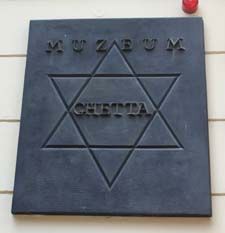 As the front receded towards the end of the war, concentration camps in the East were evacuated and their prisoners put into transports. Theresienstadt became one of the destinations for these transports. The Ghetto Museum, which opened in 1991 in the building of the former Terezín School, documents the history of the Ghetto. The exhibitions have been arranged with the assistance of former prisoners. In addition to its permanent exhibit, the Ghetto Museum also presents short-term exhibitions, documentary films are shown in the cinema, and a variety of brochures, books, videocassettes and souvenirs are on sale. As the front receded towards the end of the war, concentration camps in the East were evacuated and their prisoners put into transports. Theresienstadt became one of the destinations for these transports. The Ghetto Museum, which opened in 1991 in the building of the former Terezín School, documents the history of the Ghetto. The exhibitions have been arranged with the assistance of former prisoners. In addition to its permanent exhibit, the Ghetto Museum also presents short-term exhibitions, documentary films are shown in the cinema, and a variety of brochures, books, videocassettes and souvenirs are on sale.

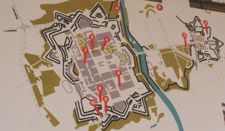 The Small Fortress originated as a stronghold designed to guard the Elbe waterway. (picture shows Ghetto to the left of the river and the Prison to the right) Soon it functioned as a military penitentiary and then as a prison for political opponents of the Habsburg Monarchy during WWI, when approx. 2,500 inmates inhabited the Small Fortress during those years. Beginning in 1940, the Small Fortress was used by the Nazis as a Gestapo Prison before the Ghetto for the Jews at the main fortress was ever established. The Small Fortress originated as a stronghold designed to guard the Elbe waterway. (picture shows Ghetto to the left of the river and the Prison to the right) Soon it functioned as a military penitentiary and then as a prison for political opponents of the Habsburg Monarchy during WWI, when approx. 2,500 inmates inhabited the Small Fortress during those years. Beginning in 1940, the Small Fortress was used by the Nazis as a Gestapo Prison before the Ghetto for the Jews at the main fortress was ever established.
 Imprisonment at the Terezin Small Fortress was reserved for Communists, anti-Fascist resistance fighters, and partisans and guerrilla fighters who were captured during the war. 32,000 men and women were sent to the Small Fortress for interrogation purposes between June 1940 and May 1945, suffering famine, disease, and torture. 2600 of them died there, including 300 who were executed. Approximately 1,500 Jews were also sent to the Small Fortress and their fate was particularly tragic. After being arrested by the Gestapo for participation in the resistance movement or for breaking the rules established for Jews at the Theresienstadt Ghetto, they were sent to the Terezin prison, given the hardest work and subjected to the worst terrorism by the guards. Prison time at Terezin, when it wasn’t fatal, was only meant to be transitory as most inmates were then sent onto other Nazi prisons, concentration camps, or execution sites. Imprisonment at the Terezin Small Fortress was reserved for Communists, anti-Fascist resistance fighters, and partisans and guerrilla fighters who were captured during the war. 32,000 men and women were sent to the Small Fortress for interrogation purposes between June 1940 and May 1945, suffering famine, disease, and torture. 2600 of them died there, including 300 who were executed. Approximately 1,500 Jews were also sent to the Small Fortress and their fate was particularly tragic. After being arrested by the Gestapo for participation in the resistance movement or for breaking the rules established for Jews at the Theresienstadt Ghetto, they were sent to the Terezin prison, given the hardest work and subjected to the worst terrorism by the guards. Prison time at Terezin, when it wasn’t fatal, was only meant to be transitory as most inmates were then sent onto other Nazi prisons, concentration camps, or execution sites.
 The entrance to the Terezin prison camp is marked by this striking black and white painted archway that takes us through the double thick fortress walls. Many parts of the walls of the Small Fortress are covered with foliage, testifying to the centuries-old age of the structures. The entrance to the Terezin prison camp is marked by this striking black and white painted archway that takes us through the double thick fortress walls. Many parts of the walls of the Small Fortress are covered with foliage, testifying to the centuries-old age of the structures.
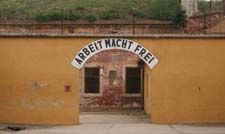 Often portrayed as the entrance to the Theresienstadt Ghetto, this familiar sign, "Arbeit Macht Frei," is actually over the archway of the passage at the Terezin prison that leads into Courtyard I, one of four courtyards, where prisoner cells and various other rooms were situated. Often portrayed as the entrance to the Theresienstadt Ghetto, this familiar sign, "Arbeit Macht Frei," is actually over the archway of the passage at the Terezin prison that leads into Courtyard I, one of four courtyards, where prisoner cells and various other rooms were situated.
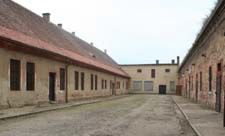 Having passed under the "Arbeit Macht Frei" sign, we entered Courtyard I, a squared-off horseshoe layout where prisoner cells were entered from off the courtyard. This First Courtyard was divided into Blocks A and B. There were 17 group cells and 20 small cells for solitary confinement. Having passed under the "Arbeit Macht Frei" sign, we entered Courtyard I, a squared-off horseshoe layout where prisoner cells were entered from off the courtyard. This First Courtyard was divided into Blocks A and B. There were 17 group cells and 20 small cells for solitary confinement.
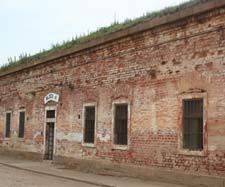 Up to 1,500 prisoners used this small courtyard as their exercise yard. Supposedly the group cells held up to 100 prisoners at one time. Cell number 1 was reserved for prisoners from the Soviet Union. Cells number 2 and number 3 were used to imprison Jews who were "arrested for political activities and violating anti-Jewish regulations." Up to 1,500 prisoners used this small courtyard as their exercise yard. Supposedly the group cells held up to 100 prisoners at one time. Cell number 1 was reserved for prisoners from the Soviet Union. Cells number 2 and number 3 were used to imprison Jews who were "arrested for political activities and violating anti-Jewish regulations."
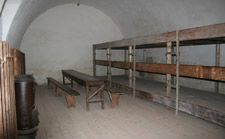 This cell is an example of some of the living facilities in Courtyard I, with wooden bunks that were expected to sleep upwards of 60 to 100 prisoners at a time. This cell is an example of some of the living facilities in Courtyard I, with wooden bunks that were expected to sleep upwards of 60 to 100 prisoners at a time.
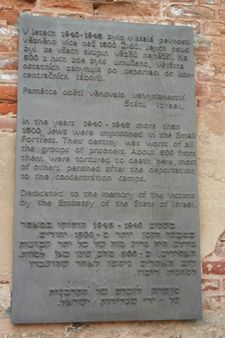 This plaque is located in Courtyard I and was donated by the Embassy of the State of Israel, inscribed in Polish, English, and Hebrew. It reads as follows: This plaque is located in Courtyard I and was donated by the Embassy of the State of Israel, inscribed in Polish, English, and Hebrew. It reads as follows:
"In the years 1940 to 1945 more than 1500 Jews were imprisoned in the Small Fortress. Their destiny was worst of all the groups of prisoners. About 500 from them were tortured to death here, most of others perished after the deportation to concentration camps. Dedicated to the memory of the victims by the Embassy of the State of Israel."
Courtyard II consisted largely of prisoner workshops (currently closed to the public). Courtyard III was opened in June 1942 with the addition of female prisoners to the Small Fortress.
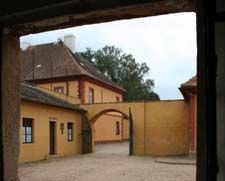 This view was taken from one of the cells in Courtyard I, looking through its doorway back to the "Arbeir Macht Frei" entrance that led into the courtyard. This view was taken from one of the cells in Courtyard I, looking through its doorway back to the "Arbeir Macht Frei" entrance that led into the courtyard.
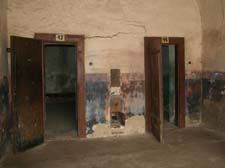 This shows entrances into the solitary confinement cells on the other side of the first courtyard. This shows entrances into the solitary confinement cells on the other side of the first courtyard.
 Larger cells in the solitary confinement block. Larger cells in the solitary confinement block.
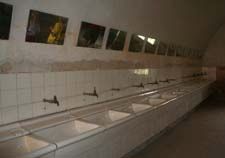 Sink facilities that were for show to appease international inspectors. Prisoners were never afforded the use of these facilities. Sink facilities that were for show to appease international inspectors. Prisoners were never afforded the use of these facilities.
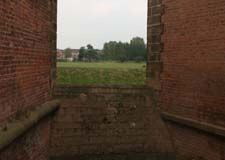 This view shows a doorway to the outside of the fortress where a successful escape by three prisoners, Milos Esner, Josef Mattas and Frantisek Marsik, was made on December 6, 1944. They escaped by walking on the ledges to an opening in the ramparts (the fortification walls). Portions of those ledges were chipped away to prevent any more escapes. This view shows a doorway to the outside of the fortress where a successful escape by three prisoners, Milos Esner, Josef Mattas and Frantisek Marsik, was made on December 6, 1944. They escaped by walking on the ledges to an opening in the ramparts (the fortification walls). Portions of those ledges were chipped away to prevent any more escapes.
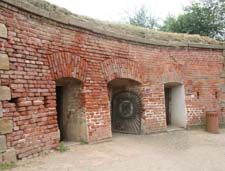 Door #18, shown here on the right, opens into the mortuary room. Corpses were stored here until they could be taken to the crematorium to be burned. Door #17 is the entrance to a tunnel that goes through the old fortifications on the north side of the Small Fortress to the former military firing range used by the Nazis for executions.The tunnel is about a quarter of a mile long and goes through the double walls of the original fortifications. Door #18, shown here on the right, opens into the mortuary room. Corpses were stored here until they could be taken to the crematorium to be burned. Door #17 is the entrance to a tunnel that goes through the old fortifications on the north side of the Small Fortress to the former military firing range used by the Nazis for executions.The tunnel is about a quarter of a mile long and goes through the double walls of the original fortifications.
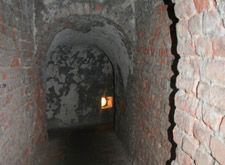 Although the tunnel is only about a quarter of a mile long, it seems more like a mile as the passageways wind around, making several sharp turns just as you think you have come to its end. The tunnel is not underground, as there are small portals in the thick walls throughout the passageways, allowing you to see into other courtyards. Although the tunnel is only about a quarter of a mile long, it seems more like a mile as the passageways wind around, making several sharp turns just as you think you have come to its end. The tunnel is not underground, as there are small portals in the thick walls throughout the passageways, allowing you to see into other courtyards.
 Upon exiting the tunnel, we came to this site, where the fortification walls in the background mark the spot where condemned prisoners stood, who were to be executed by firing squad, which is in the center of the picture. Between 250 and 300 of the 32,000 prisoners at the Small Fortress were executed. This included 49 men and 3 women who were shot on May 2, 1945 just before the prison was liberated. The first recorded execution was Frantisek Prokop on May 11, 1943, who was shot here. On September 28, 1944, Dr. Paul Eppstein, the second Elder of the Theresienstadt Ghetto was executed here because of his resistance activities. Upon exiting the tunnel, we came to this site, where the fortification walls in the background mark the spot where condemned prisoners stood, who were to be executed by firing squad, which is in the center of the picture. Between 250 and 300 of the 32,000 prisoners at the Small Fortress were executed. This included 49 men and 3 women who were shot on May 2, 1945 just before the prison was liberated. The first recorded execution was Frantisek Prokop on May 11, 1943, who was shot here. On September 28, 1944, Dr. Paul Eppstein, the second Elder of the Theresienstadt Ghetto was executed here because of his resistance activities.
 The gallows, pictured here, were used only once to hang three condemned prisoners. Near this site are the mass graves where 601 corpses were exhumed in the summer of 1945 and reburied in the Memorial Cemetery in front of the main entrance. The gallows, pictured here, were used only once to hang three condemned prisoners. Near this site are the mass graves where 601 corpses were exhumed in the summer of 1945 and reburied in the Memorial Cemetery in front of the main entrance.
 By 1943, the Terezin Prison was running out of room. Between 1940 and 1945, the number of prisoners housed in the Small Fortress increased significantly. In 1940, there was an average of 150 prisoners housed in the Small Fortress. By 1941, this had increased to 600; by 1942 to 1,200; by 1943 and 1944 to approximately 2,000; and by 1945 to 5,500 prisoners. To house the additional prisoners, the SS added Courtyard IV, pictured here. By 1943, the Terezin Prison was running out of room. Between 1940 and 1945, the number of prisoners housed in the Small Fortress increased significantly. In 1940, there was an average of 150 prisoners housed in the Small Fortress. By 1941, this had increased to 600; by 1942 to 1,200; by 1943 and 1944 to approximately 2,000; and by 1945 to 5,500 prisoners. To house the additional prisoners, the SS added Courtyard IV, pictured here.
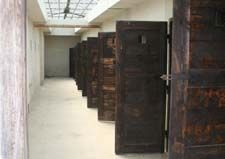 Though construction was begun in 1943, the first prisoners were not moved here until the Fall of 1944. Courtyard IV consists of several large mass cells which held between 400 and 600 prisoners each as well as small cells for solitary confinement. But with the extra increases of prisoners in 1945, the crowding was so extreme that even the solitary confinement cells were used as mass cells. At the end of the war, 3,000 inmates lived in Courtyard IV alone. Though construction was begun in 1943, the first prisoners were not moved here until the Fall of 1944. Courtyard IV consists of several large mass cells which held between 400 and 600 prisoners each as well as small cells for solitary confinement. But with the extra increases of prisoners in 1945, the crowding was so extreme that even the solitary confinement cells were used as mass cells. At the end of the war, 3,000 inmates lived in Courtyard IV alone.
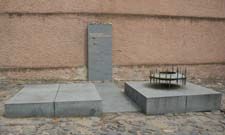 This is a memorial on the site to those who had been deported to concentration camps. The plaque names 13 camps, including: Auschwitz, Bergen-Belsen, Buchenwald, Dachau, Flossenbürg, Gross-Rosen, Mauthausen, Ravensbrück, Sachsenhausen, and Stutthof. This is a memorial on the site to those who had been deported to concentration camps. The plaque names 13 camps, including: Auschwitz, Bergen-Belsen, Buchenwald, Dachau, Flossenbürg, Gross-Rosen, Mauthausen, Ravensbrück, Sachsenhausen, and Stutthof.
 This memorial in the exhibit hall has samples of soil from concentration camps where inmates from the Terezin Prison and the Theresienstadt Ghetto were deported and died. This memorial in the exhibit hall has samples of soil from concentration camps where inmates from the Terezin Prison and the Theresienstadt Ghetto were deported and died.
 From late April to early May of 1945, during the Nazi retreat, which brought thousands of evacuated prisoners from the eastern camps, epidemics of numerous diseases started. As a result, many liberated prisoners, volunteer medical personnel, and Red Army liberators died weeks after the war ended. On the initiative of the newly formed Czechoslovak government, the National Suffering Memorial was opened in 1947 - it was later renamed the Terezin Memorial. From late April to early May of 1945, during the Nazi retreat, which brought thousands of evacuated prisoners from the eastern camps, epidemics of numerous diseases started. As a result, many liberated prisoners, volunteer medical personnel, and Red Army liberators died weeks after the war ended. On the initiative of the newly formed Czechoslovak government, the National Suffering Memorial was opened in 1947 - it was later renamed the Terezin Memorial.
Return to top of page
| |



